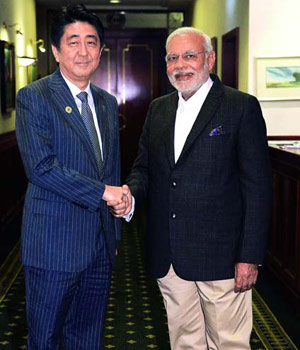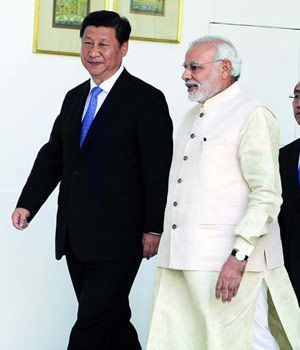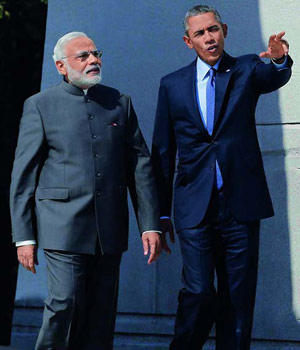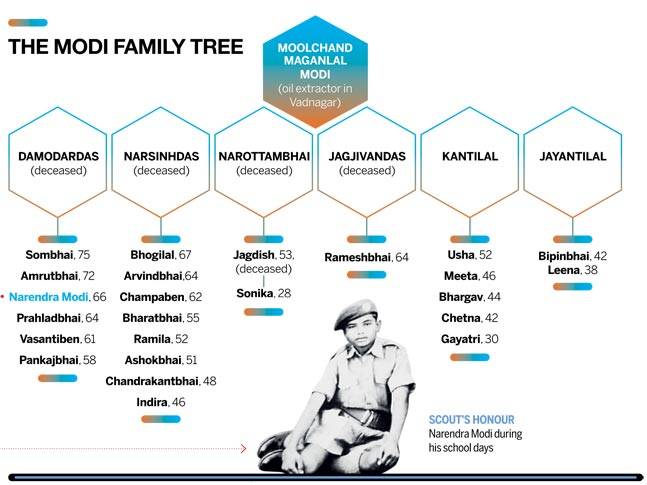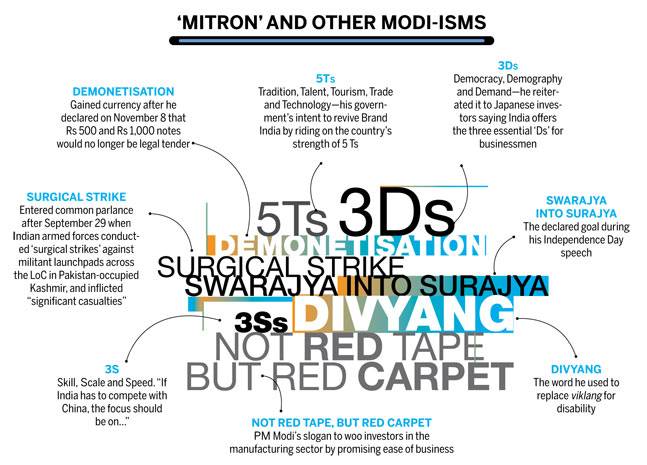Narendra Modi
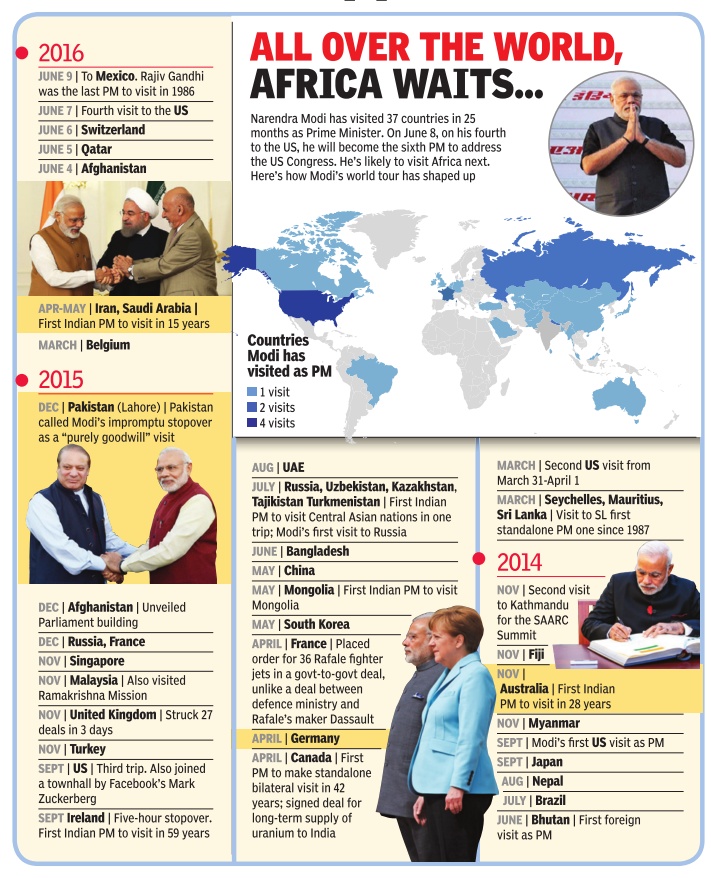
This is a collection of articles archived for the excellence of their content. |
A profile
Rajdeep Sardesai
December 25, 2014
India's most powerful prime minister in decades,Narendra Modi has become the focal point of a young nation's aspiration for a better tomorrow
In 2014, Narendra Modi was literally everywhere. On the campaign trail, with clenched fist and self-proclaimed 56-inch chest, Modi was the defining symbol of an India hankering to be liberated from the effete elitist UPA, roaring out a near universal echo against silver spoon-fed dynasts and ancien regime aristocrats. Ranging around with furious energy from Amethi to Chennai, from Bastar to Kerala, he rode tidal waves of expectation, each of his appearances a call to overthrow the old order, the up-by-his bootstraps "chaiwallah" flaunting his humble origins and perfect wardrobe as if to say, "If I can, you can too." Class warrior against the Oxbridge elite yet capitalist-friendly to desi business, Hindutva champion yet armed with modern high-tech media, the publicly endorsed emblem of a globalising India with a triumphant eye turned towards the Vedic Age.
Indeed, power in the country now flows from a designer kurta that was once made in Gujarat. Recently, on a chilly December evening, Rashtrapati Bhavan held an event to celebrate the construction of a new wing of the Ceremonial Hall. The Lutyens power elite were in attendance: ministers, governors, service chiefs, and the Rashtrapati himself. Dot on the appointed time, in walked the Prime Minister in his trademark salwar kurta, not a hair out of place. The chatter in the room shrank sharply to pindrop silence, as gathered VIPs jostled to catch the eye of the Supreme Leader. In 2014, Modi has become truly larger than life. Armed with a massive majority for the first time after 25 years of coalition governments, he's arguably the most powerful PM India has seen since Indira Gandhi in the 1970s.
It wasn't always quite like this. In 2002, Modi made it to the cover of this magazine for the first time. He was then labelled a "Master Divider", a politician who had presided over the terrible Gujarat communal violence that had left more than 1,000 people dead. He had become a sharply polarising figure: to his critics, he was a Hitler-like despot, someone who had knowingly failed to stop the killing of innocent Muslims. To his supporters, he was a 'Hindu Hriday Samrat', a macho leader who had protected the majority community in the aftermath of the Godhra train burning in which 56 kar sevaks were killed. The Congress leadership called him a "maut ka saudagar" (merchant of death); his flock called him "Gujarat ka sher" (lion of Gujarat). Never before has an individual so starkly divided public opinion.
Turn the clock a little further back. It's the 1990s and Modi is struggling to make his way up the political ladder. In a slowly rising BJP, clawing its way up to challenge Congress hegemony, he wasn't even a first among equals among his party's Generation Next. There was Pramod Mahajan, the suave man Friday and strategist for then prime minister Atal Bihari Vajpayee. Sushma Swaraj was an electrifying campaigner while the sagacious Govindacharya was party ideologue. As a pracharak who had never fought an election. He was neatly attired even then, was an effective party spokesperson on television, and had shown superior organisational skills during the yatras of L.K. Advani and Murli Manohar Joshi. But he never was in the front row of the BJP's potential successors to the Vajpayee-Advani duo. What he did possess though was an unshakeable self-belief, a dogged conviction that he was destined for greater things. There was a single-mindedness of purpose: he was a loyal karyakarta, unwaveringly committed to the growth of the BJP, but he was also fiercely individualistic, the ruthless practitioner of realpolitik who would not hesitate to sideline a political rival.
If 2002 and its immediate aftermath revealed a darker side of the Modi persona as the unflinching flag-bearer of divisive Hindutva politics, the years that followed showed another side to his image. From Hindutva icon to governance guru, Modi crafted a makeover that was deliberate and strategic, but also the result of hard work and a constant quest for self-improvement. When he took charge as Gujarat CM in October 2001, he self-confessedly had never sat in a government office or worked on government files. But he was determined to succeed. He built a reputation as a "karmayogi" politician who could work with the bureaucracy in effectively micro-managing government programmes: 24x7 power, girls education, irrigation schemes. Modi harnessed the state administration into an effective project-driven machine under his leadership.
There were, in a sense, two turning points in Modi's political career. The first was, undoubtedly, the train burning in Godhra and the riots that followed, where he acquired a distinct political identity by refusing to appear remorseful or apologetic for the state's administrative failure. The second defining moment came on October 7, 2008 when the Tata group announced it would set up a Nano plant in Sanand in Gujarat. The decision to move the plant from Bengal to Gujarat gave Modi what 2002 or election triumphs could never give him-credibility as a trustworthy administrator.
It was at this point that Modi's ambitions began to soar well beyond Gujarat. The riots had left him politically isolated; Tata's vote of confidence, recognition from a well-respected corporate citizen, gave him the self-confidence that the tide had turned. He unleashed a public relations blitz positioning himself as a politician committed to good governance, as a leader who was incorruptible and who had driven a "Gujarat model" of high growth and robust infrastructure. The Gujarat model and the cult of Modi would henceforth be inseparable.
The was now pitching himself as the icon of what he described as the "neo-middle" class. This "neo-middle class" was Modi's answer to the Congress's "aam admi" and would, eventually, form the core of his appeal ahead of the 2014 elections. Modi defined this constituency as the "aspirational" India, the India restless for a better life and upward mobility, a class which was, ironically enough, a beneficiary of the great economic transformation triggered in 1991 by the Narasimha Rao-Manmohan Singh dispensation. Singh changed the economy but didn't quite understand the political upheaval it unleashed. Modi, in fact, grasped the politics created by the Great Change of '91 better than the Congress did.
Today, liberalisation has created a generation of young Indians for whom wealth creation and social and material advancement have become the fundamental markers of the good life, a mindset sharply at odds with their licence-permit raj-era parents and grandparents whose ambitions may have centred around government jobs and academic qualifications. This class-socially conservative on religious identity and cultural roots yet pushing towards economic liberalism and a relentless focus on growth-was a potential catchment area for an avowedly right-wing party which in the quest for newer voters had started to embellish its Hindu roots and aggressive nationalism with the promise of good governance.
To this class, in a rapidly changing and urbanising India, Modi was offering, quite simply, hope, as symbolised in his election promise of "achche din aayenge". Not surprisingly, the highest support for the BJP in the 2014 elections came from "young" Indians and first-time voters: a CSDS election study shows that as many as 42 per cent Indians in the age group of 18 to 25 wanted Modi as their PM as against just 16 per cent who wanted Rahul Gandhi.
It is one of the more fascinating features of the 2014 elections that the 64-year-old leader had a higher rating among younger voters than his prime opponent who was 20 years younger. Modi appeared to connect with the young, constantly communicating with them, be it while addressing town hall meetings in college campuses or through his crack communications team that focused on youthful social media sites such as Twitter and Facebook. Rahul, of whom it could be said that he never missed an opportunity to miss an opportunity, doesn't even have a Facebook or Twitter account.
It isn't just Rahul to whom Modi should send thank you cards this new year for assisting in his "Mission 272" project. He should certainly send a thank you card to Manmohan Singh. The former prime minister, Sonia Gandhi's appointed wazir, was the soft-spoken scholar, hopelessly at sea, surrounded by a charged media, demanding citizenry and fierce calls to accountability. The gentle Sardar retreated into prolonged silences in the face of mounting charges of corruption against his ministers, giving the glaring impression of an absentee PM who had surrendered the executive space. In Uttar Pradesh, Akhilesh Yadav was shown up to be a political novice, struggling to handle the complexity of India's most populous state. In the other key state of Maharashtra, Ajit Pawar with his infamous "let the farmers urinate in dams" remark was seen to typify the moral bankruptcy of a ruling clique which was now being labelled as the "nationalist corrupt party". Mani Shankar Aiyar, with his chaiwallah statement, only scored one of the Congress's biggest self-goals, a sneeringly condescending remark which enabled the BJP's PM candidate to go to town with a contrast between his own self-made achievements with the privileges of an entitled born-to-rule class.
There should also be a thank you note sent to the media, a large section of which became cheerleaders of the Modi juggernaut. Modi is a made-for-TV politician: he is a terrific orator, has a narcissistic love for the camera, and an uncanny knack to know what will make "news". In a soundbite-driven public discourse, Modi used the media, and television in particular, to position himself as a strong, bubbling-with-ideas leader who would rid the country of sloth and corruption. For the media, Modi was TRP (television rating points) and it seemed like we were in a permanent embrace with the BJP mascot, his images beaming out of every media outlet.
The campaign itself was quite brilliant: it used a deadly mix of media, money and technology to literally shock and awe the opposition. Modi in 3D, for example, showed how high-end technology could be used to spread the message of Modi Everywhere; a missed call and an SMS showed how the cell phone could be tellingly used to build a volunteer base; a video rath beamed out to 'media dark' villages in UP and Bihar and bridged the rural-urban divide. Nor was it a one-man show.
And yet, truthfully, the media did not create the Modi wave as much as simply ride on it. The "wave" (which Shah described as a "tsunami" or "tsunamo") was created by a political environment in which low growth, rising inflation, big-ticket corruption had bred a sense of negativism, even defeatism in the minds of voters. The voter was looking for an Arnold Schwarznegger-like Terminator who would offer instant solutions to a nation's problems.
A post-election study showed that 27 per cent or one in every four of those who voted for the BJP said they did so only because of Modi. Given the low morale in the Congress, the BJP would probably have been the number one party in any case but it was the Modi factor that brought in the incremental vote that pushed the party into the seemingly unthinkable territory of a majority on its own. He was, as a senior Congressman conceded, "a leader at the right time, at the right place, in the right context".
On May 26, 2014, Narendra Damodardas Modi was sworn in as India's fifteenth prime minister, the chief executive of the country's first unabashed Hindu nationalist government. This wasn't an unwieldy coalition in the Vajpayee-led NDA mould; NDA 2 was a BJP government where allies, even long-standing ones such as the Shiv Sena, had to be completely subservient to the BJP leadership. The swearing-in ceremony itself had a quintessential Modi touch. It wasn't held in the conventional Durbar Hall but in the forecourt of Rashtrapati Bhavan: a ceremony aimed to announce the arrival of the "outsider" and the new Delhi durbar.
Modi's always been an excellent impresario: his swearing-in too was a remarkably well-crafted event. The presence of the leaders of SAARC countries for the first time, including Pakistani PM Nawaz Sharif, was again designed to create a stir and project the new prime minister as a putative statesman. Apparently, Ministry of External Affairs officials didn't know about the plan until the very last moment. In typical Modi style, he wanted to shake up the establishment. He takes pride in his "outsider" image, someone who doesn't want to be chained by the protocol and rules of Lutyens' Delhi, someone who is so strikingly singular that he didn't even invite his family for the swearing-in. By contrast, corporates, film stars, even his old Hindutva comrades such as Sadhvi Ritambhara were in attendance. "Mr Modi isn't going to decide his invitations based on traditional definitions of political correctness," is how one of his aides described the invitee list.
He played the showman role again in the US, turning Madison Square Garden into an NRI lovefest; he even dropped in to a music festival in Central Park and rubbed shoulders with Hollywood hero Hugh Jackman and greeted the crowd with a "may the force be with you", the Star Wars-style, rather quaint 1970s chant. The US may have denied him a visa for years in the aftermath of the riots, but Modi wasn't letting that come in the way of taking a stab at becoming a global leader.
Modi's penchant is for headline-grabbing one-liners at prime time (for example, his anti-corruption slogan 'na khaoonga, na khane doonga'); he likes to identify himself with inspirational figures (Sardar Patel one day, Vivekananda the next) and prefers to market simple but salient ideas that he thinks will resonate with a larger audience. His Independence Day speech was a performance more than just a traditional address to the nation. He promised to abolish the Planning Commission and made toilet building his new mission. "What kind of PM stands at Red Fort and talks about toilet building?" he asked with a rhetorical flourish. Swachh Bharat, a concept that he formally launched on Mahatma Gandhi's birthday, is a campaign to spread the message of cleanliness.
Symbols and messages come easily to Modi, even though a more classical right-wing government would probably have opted for incentives rather than for social engineering of the Swachh Bharat kind, for a lesser role for the government than for an overweening position for the PMO. Is Modi a believer in right-wing market-friendly economics or is he in fact only delivering a more efficient UPA? That question hangs in the air. Those who had hoped that Modi would be India's Ronald Reagan or Margaret Thatcher may be in for disappointment because Modi's economics is likely to be dictated entirely by his politics rather than a free market capitalist vision. This is the UPA with saffron lipstick, complained columnist Swaminathan Aiyar after the Government's maiden Budget.
Interestingly, the UPA government too had spoken of a Nirmal Bharat Abhiyan with a focus on sanitation. "We even had actor Vidya Balan as our brand ambassador, only we didn't know how to market it quite like Mr Modi," Jairam Ramesh remarked rather ruefully at the Aaj Tak Agenda conclave. However borrowed the schemes may be, even his critics now admit that Modi is the master communicator with an instinct for artful messaging. Rajmohan Gandhi, grandson of the Mahatma, says that it's a gift which even the Father of the Nation possessed. "The important difference is that while for Bapu the message was all-important, Modi is keener to market himself first," Gandhi told me recently.
Modi though is perhaps clever enough to realise that eventually the message will have to triumph over the individual and substance will have to override slogans. In 2014, the individual and his slogans have been dominant: even today he seems in perpetual campaign mode, sometimes in tribal headgear, sometimes in a Kashmiri phiran, addressing rallies in some corner of the country, rousing NRIs across the world, delivering Sunday sermons on All India Radio. He has made multiple promises, raised expectations, energised the bureaucracy, created an aura of invincibility around himself.
Indeed, with every passing election, it is becoming clearer that the battlelines in Indian politics are drawn as Modi versus the rest: even sworn enemies such as Lalu Prasad and Nitish Kumar have been forced to come together in a desperate bid to try and stop Modi's electoral rath from trampling through Bihar. He is the glue that unites a disparate opposition, much like Indira's dominance in the 1970s created a 'khichdi' called the Janata Party. With the Congress still struggling to come to terms with its electoral debacle, the opposition space has shrunk. It has been left to a Mamata Banerjee, feeling threatened in her bastion in West Bengal, to lead the charge, a sign that self-preservation is dictating the terms of the political debate against Modi Raj.
With his trusted lieutenant, Amit Shah, as BJP president, Modi has also ensured that the party is firmly in his control. The old guard has been effectively retired to a 'margdarshak mandal' while his peers have little choice but to accept Modi's absolute leadership. Shah appears to have mastered the electoral math, and while the slogan of "Congress mukt Bharat" raises the troubling spectre of authoritarian oneparty rule, it also reflects the sheer audacity of ambition to create an impact from Kashmir to Kanyakumari. And while the Valley has been immune to the blossoming of the lotus in 2014, the fact that the Modi-Shah combine could speak of a "Mission 44" in the Jammu and Kashmir elections confirms their determination to occupy mindspace at all times.
And yet, Modi isn't the universal messiah his bhakts would like to project him as. For a loquacious politician, he has stayed worryingly silent when Hindutva hotheads have raised issues such as 'love jihad' and conversions, thereby widening the trust deficit with minorities (he broke with tradition and refused to hold the prime minister's annual iftar party and rejects wearing a skull cap as tokenism even while happily adding every other dress code to his wardrobe). He hasn't yet been able to push major economic or institutional reform, or revive manufacturing, he still hasn't broken logjams in Parliament and hasn't dealt with critical issues of Centre-state relations. Modi's relationship with the Sangh also remains unclear: is the powerful Prime Minister in control of the Parivar within? Will all executive decisions be soundtested for Sangh acceptability?
Sooner or later, the media honeymoon will end and the tough, but rather prosaic task of governing India outside the glare of the TV camera will have to begin. 2014 was the year of the campaigner: an election was won by the sheer force of personality. 2015 could well be the year of the administrator, where promises made will have to be backed by performance. Voters have seen Modi on TV, social media and in 3D, now they need to see him in flesh and blood.
Personal life
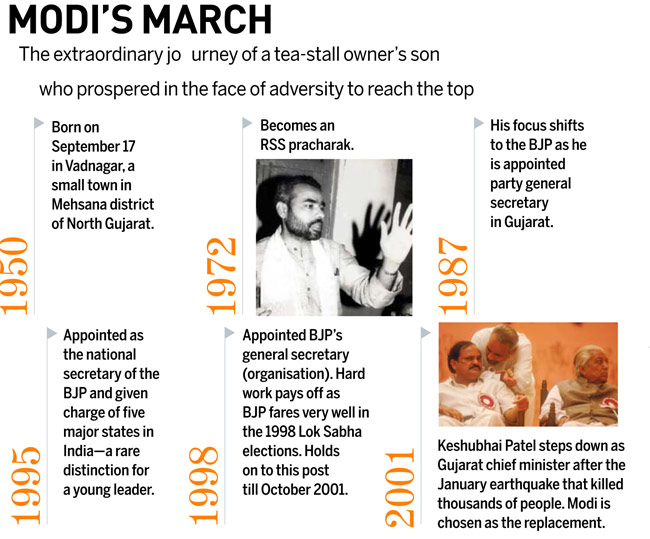


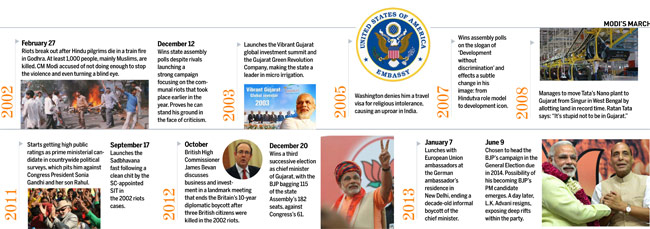
It's the life lessons that he picked up as a man of humble beginnings that will keep Prime Minister Narendra Modi in good stead Narendra Modi may have emerged as a skilful administrator and a man with the flair for marketing his vision with flashy taglines, but his life story is one of easy simplicity peppered with an intermittent but undeniable bohemian streak. His rise from the son of a tea-shop owner to one of India's most powerful prime ministers is not without its share of fascinating anecdotes and incidents that shaped his nowtowering personality.
Born in 1950, Modi grew up in a small three-room house as one of six children of Damodardas Modi, who owned a small tea shop at the railway station in Vadnagar in north Gujarat. A young Modi would help his father at the stall after school and often double up as a delivery boy carrying a metal cup-holder filled with tea glasses.
At Shri B.N. High School in Vadnagar, where he studied until the 11th standard, Modi was recognised as a brilliant student. Not surprisingly, he was the best orator in his class and took part in school dramas- once playing the role of the Maharaja of Bhavnagar. His extracurricular repertoire extended to being a fine NCC cadet. "He was truly multifaceted," says Sudhir Joshi, a classmate who still lives in Vadnagar. Adds Nagji Desai, another classmate with whom Modi used to spend a lot of his free time: "In whatever he did at school, he was always number one."
The five-year period from when he turned 17 was a phase of great turbulence for Modi, and perhaps the part of his life that made the deepest impact on his personality. When he was barely 18, his parents forced him to marry Jashodaben, a girl from his own oil-tiller community, against his wishes.
Apologising to his young wife for not being strong enough to have made the decision earlier, he walked out of his marriage and went to the Himalayas for three months, and then moved to Ahmedabad permanently on his return.
Small beginnings
In Gujarat's biggest city at the end of the 1960s, Modi took up the job of a supervisor in the Gujarat State Road Transport Corporation canteen. Though Modi didn't care much about the kind of food he ate-khichdi and kadhi being his staple-he was always fond of clothes, shoes, and accessories.
Rising through the ranks
Between 22 and 25, Modi worked as pracharak in Sanghrelated bodies and also as a district pracharak. The turning point came when Indira Gandhi imposed Emergency in 1975. Modi stepped forward as a key strategist for the Sangh, remaining underground for several months to help anti-Congress political forces.
Modi's next noticeable contribution was helping the victims of the Morvi dam disaster in 1979. Modi, who was in Chennai when he heard about the dam burst, rushed to the spot within 12 hours and was instrumental in floating a trust for the families of those affected.
In 1986, Modi was transferred to the Gujarat BJP as its organisational secretary. He became a key strategist for the BJP in the state for the Ayodhya Ram Mandir agitation and, in the backdrop of poor relief work by the state government during the 1987-1989 drought, started the Nyaya Yatra with Vaghela to seek justice for drought victims.
Propelled into the limelight as an emerging leader, Modi played a key role in the 1989 Lok Sabha elections and the state Assembly elections in early 1990. The BJP's creditable performance in the two elections firmly established him as a key political and electoral strategist, and even won him a place in the 11-member national election committee of the BJP for the 1991 Lok Sabha polls.
Modi visited the United States at least four times between 1990 and 2000 and spent time with the Indian diaspora. Kanchan Banerjee, a technocrat in Boston at whose house Modi dined on several occasions, gives an example of his love for the latest gizmos: "One time, when my family forced him to accept a gift from us, Modi reluctantly asked for the latest laptop, a version even we weren't even using at home at that time. It was a surprise that he was so well-versed in the latest technology."
Despite being a tough taskmaster, Modi's softer side is visible in his attention to detail as far as the finer points of personal etiquette go. Soon after the 2007 Vibrant Gujarat Summit in Ahmedabad, for example, an aide told Modi that it was a mistake to ask Sanjay Lalbhai of Arvind Mills to sit in the last row on the dais because he was an industrialist of repute and his grandfather Kasturbhai Lalbhai was known as a generous philanthropist. Modi's Principal Secretary K. Kailasnathan immediately sent a letter of apology to Lalbhai, who was pleasantly surprised by the gesture.
A deeper insight into Modi's philosophy can be gathered from his collections of poems Aankh Aa Dhanya Che ("Oh Eye, I am grateful to you"), and Sakshibhaav, a book in which Modi has shared his musings from his diary in the mid-1970s when he had not yet entered politics. But there is also a ruthless streak in Modi, evident in how he crushed all opposition within his own party, first in Gujarat where he was embroiled in a tussle with Keshubhai Patel and Sanjay Joshi, and then at the national stage where he sidelined a reluctant BJP leadership to emerge as the party's prime ministerial candidate in 2013.
With the era of Modi upon us, there will be many hypotheses and expositions on what the Prime Minister's motivations are, and how they have been derived. Be that as it may, it cannot be denied that our Newsmaker of 2014 has led a simple life that could not have been less ordinary.
Communication skills
Social media style
Prime Minister Narendra Modi’s tweeting patterns have caught the eye of American media researchers, particularly his use of sarcasm as a social media weapon.
A study published in the International Journal of Communication this week shows he tweets under nine broad themes: cricket, RahulGandhi(opposition leader), entertainment, sarcasm, corruption, development, foreign affairs, Hinduism, and science & technology. But what struck researchers was his “use (of) political irony and sarcasm to become broadly appealing and refashion his political style.” After analysing more than 9,000 tweets over six years, they found sarcastictweetswere concentrated around elections.
“We try and explain what makes him popular,” said Joyojeet Pal, University of Michigan’s assistant professor of information who led the study. “Modi’s irony provides a form of political spectacle and resonated on social media as shown by high retweeting of his sarcastically wordedmessages.”
In tweets during national polls, the study said, Modi referred to the main opposition party as corrupt and Rahulas “Rahul Baba” or “Shahzada (prince)”. Using humour and sarcasm, he was signaling that the Congress was not in touch with its roots and letting hisown followers get the inside joke, researchers said. One such tweet goes: “The way Rahul Baba is making statements with a dash of comedy in them, I think the TV show of Kapil Sharma may soon have to shut shop”.
At 36 million, Modi has the second largest following on Twitter among world leaders, with Donald Trump topping the chart at 42.8 million followers. Rahul’s official Twitter handle has 4.36 million followers.
The researchers said Modi’s useof sarcasm buildson a longer tradition of slogan humour during political rallies. “There are plenty of attacks, rhetoric, cleverly worded jibes and jokes,” Pal said. But there hasn’t been much snarkiness in November. His last attack on Congress was on November 2: “Congress has become a laughing club. They are non-serious about important issues and are heavily involved in corruption.” Instead, it was @OfficeOfRG that tweeted, “Modi ji - nice touch removing the suit. What about the loot?” in a referencetoRafaledeal.
The researchers said although social media did not reach many “traditional rural and peri-urban uppercaste Hindu voters of BJP, they extended Modi’s appeal to a new young urban constituency.” “After the election, the celebrity mentions and tweets about foreign policy increase,” Pal said.
The researchers said the sarcasm helped separate Hindutva-oriented content, traditionally more divisive than the pan-Indian patriotic rhetoric of “India First”, through which Modi gained a more secular standing.
“The power of Modi’s message is in the juxtaposition of his past as a train station tea-seller alongside his present as a selfie-clicking leader of a strong aspirational but fundamentally nationalist state,” Pal said. “Sarcasm is as much a message from Modi as it is a message about him.”
The economy’s performance
2014-17
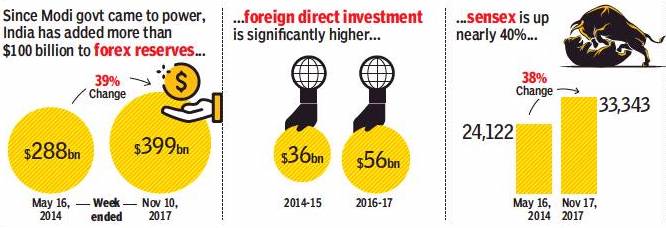
From November 18, 2017: The Times of India

From: November 18, 2017: The Times of India
See graphics:
Key indicators of the state of the Indian economy, Forex reserves, Foreign Direct Investment, Sensex, May 2014-Nov 2017
Key indicators of the state of the Indian economy- exchange rate, change in crude prices, rate of inflation, GDP growth, fiscal deficit, investment and structural reforms, May 2014-Nov 2017
Emergency (1975-77)
Sangharshma Gujarat : excerpts
Leena Misra, July 5, 2023: The Indian Express
THE “brotherhood” between the R S S and Jamaat-e-Islami Hind cadres while sharing prison space during the Emergency; the Sangh’s insistence on “Gandhian” ways of protest, abjuring violence; the underground network that kept letters running from jail to activists abroad; the dependence on BBC for news; planning protests to coincide with Jawaharlal Nehru’s birth anniversary; and using an event attended by world leaders to embarrass the Central government.
These were some of the tactics used by underground political activists during the Emergency, as recounted by Prime Minister Narendra Modi in a book, which he spoke about during his recent Mann ki Baat address. Modi said the Emergency, imposed on June 25, 1975, was “a dark period in the history of India” and went on to mention that he too had written a book describing the period.
The book, Sangharshma Gujarat (Gujarat in Struggle), written in Gujarati, was released in 1978, a year after the Emergency was lifted. It was the first book that Modi, who was then an R S S pracharak in his late 20s, wrote. It was last reprinted in 2008 – a third reprint – when Modi was into his second elected term as the Gujarat Chief Minister.
Modi writes about spending time in hiding and gives details about the disguises and strategies they assumed to escape the authorities.
Gujarat was one of the nerve centres of the movement against the Emergency imposed by the Indira Gandhi government, as it had a non-Congress party in power.
The Janata Morcha regime in the state was led by Babubhai Jashbhai Patel, who had swept to power around the time the Emergency was imposed, and was supported by the Jan Sangh (the precursor to the BJP) from outside.
Modi writes about how the R S S hoped that Gujarat, which was already seething against the Centre following the student-led Navnirman Movement, would fuel the resistance against Indira Gandhi. “One priority was to keep Gujarat’s pratrikar (power to resist) alive, the other was to connect with all the underground rebellions across the country… Because there was a Morcha sarkar in Gujarat, there were no restrictions on rallies.”
“Thus, in the first week of Emergency, Gujarat used all the Gandhian weapons,” writes Modi, adding that the suggestion of socialist leader George Fernandes that armed resistance was the only way to defeat Indira was resisted by the Sangh.
According to Modi, “Shri George was of the clear view that Indiraji would never withdraw. It was his conviction that in such a situation, armed resistance was the only way out and he felt that the Sangh, without much delay, should take such a task on hand for the sake of the nation… But whatever the challenges, the Sangh was very clear. It did not wish for a revolution or change by means of violence.”
Modi says the R S S and Jan Sangh saw the anti-Emergency protests as the “Second War of Independence”, and talks about leaders from various ideologies coming together to fight against the “dictatorial leadership of Shrimati Gandhi”, with many of them visiting Gujarat.
Among the leaders he mentions are Jayaprakash Narayan, Subramanian Swamy (who is referred to as Dr Swamy in the book), Sardar Vallabhbhai Patel’s sister Maniben, Morarji Desai, L K Advani and Atal Bihari Vajpayee, among others.
In 1976, Advani became a Rajya Sabha MP from Gujarat, while lodged in a jail in Bengaluru under MISA.
One of the outfits Modi mentions is the Jamaat-e-Islami Hind (JIH), which like the R S S was banned, with their members often lodged in jail together.
Modi writes: “Given the mix of people from various ideologies in jail, there would be heated debates, yet there was an amazing camaraderie. The Congress’s attempts to portray the Sangh karyakar as enemies of the Muslims were foiled by the Sangh karyarkars’ behaviour towards them in jail. There was an unbelievable brotherhood between the Sangh workers and their Muslim friends! Maintaining complete discipline when they read the namaz. In the month of Ramzan, the Sangh workers would wake up at 2 am and cook for their Muslim friends.”
Former Gujarat CM Shankersinh Vaghela learnt Urdu from JIH members, Modi writes. “The friends from Jamaat would participate in all programmes.”
The book also describes hoodwinking jail authorities to get information to the outside world. “Many solutions would have to be worked out, and it would be inappropriate to mention them at this moment, but our underground arrangement was so perfect that a letter written by Ratnakar Bharti, a spokesperson of BBC based in London, to his friend in jail, reached the latter through the underground route, and in just four days Shri Ratnakar got its reply in London,” writes Modi.
He adds that the Sangh members outside had such detailed information regarding the jail and their colleagues in it, that “if anybody would be caught with these papers, that person could be proved guilty of attempted jailbreak”. “The entire picture, the entry points, the sentries’ quarters, the police jawans in jail, the number of officers posted in jail, their daily routine, their ideology, all this information would be collected by some enthusiastic friends and sent outside… an arrangement was also made for our friends in jail to listen to BBC news,” Modi writes.
Modi goes on to write about selecting the birth anniversary of Nehru, November 14, as the day to launch a statewide agitation against his daughter Indira. The Janata Morcha government also recreated the Dandi Yatra, with a ‘Sangharsh Kooch’ from Ahmedabad to Dandi in August 15-30, 1976, that was led by Sardar Patel’s daughter Maniben.
“Those who joined this kooch were arrested under the DIR (Defence of India Rules), but the government knew the perils of arresting Maniben, thus she was spared,” the book says.
Modi recounts another instance when the protests against the Emergency were taken to the heart of the government. Sangh workers were given the responsibility of printing anti-Emergency and anti-Indira leaflets in English and distributing the same among delegates at a Commonwealth meeting in Delhi, and at a Congress Working Committee meeting in Chandigarh.
The task of distributing leaflets in Delhi fell on then Jan Sangh legislator Suresh Mehta, Modi writes. Mehta was sent as a representative of the Babubhai Patel government to the Commonwealth meeting. “With lots of courage and caution, he (Mehta) handed out these Lok Sangharsh Samiti leaflets exposing the government to the delegates, and before the government realised this, it was all over.”
Modi talks in the book of the Lok Sangharsh Samiti, founded by Jayaprakash Narayan, that spread its outreach as far as the US and UK, despite its members being under surveillance. The Sangh’s Laxmanrao Inamdar, popularly known as “Vakilsaheb”, took the lead and made Gujarat the nodal state for four centres – Ahmedabad, Bangalore, Mumbai and Delhi – for resisting Indira, Modi writes.
He identifies a “Shriman K (Mr K)” as the man given the task of flying to these centres every 10 days and meeting key people.
Modi says that the Sangh also got its message across via fronts like entertainment clubs, bhajan mandalis and welfare mandalis. “Those working for undercover activities in the public domain were given new names and we got used to such undercover meetings,” he writes, revealing that he himself went by the name ‘Prakash’.
Recounting his first meeting with Fernandes, Modi writes: “ …a yellow Fiat car pulled over outside the gate. A strongly built man wearing an un-ironed Lukhnavi kurta, a green cloth wrapped around his head, a chequered lungi and a long beard, giving the impression of a Muslim fakir and known as ‘baba’… George entered.”
The then editor of Sadhana, an R S S-backed periodical, and veteran journalist Vishnu Pandya, who was among those arrested during the period, tells The Indian Express that the Navnirman Movement and the resistance to the Emergency became “a taalim kendra (school of learning) for Narendra Modi”.
On whether such a resistance would be possible today, given the strict measures seen as anti-dissent, Pandya says, “Firstly, today the Opposition does not have the strength to sustain such a movement. If the fight is to save democracy, then it will sustain, but today the Opposition is coming together not for the love of democracy but for the love of power… They don’t want Modi, or the BJP or the R S S. JP (Jayaprakash Narayan) had made it very clear that the fight should not be centred around individuals… Today nothing will be as effective.”
Family
Untouched by Modi’s rise
Akhilesh Singh, Family remains untouched by Modi’s rise, November 30, 2017: The Times of India
Around midday, 75-year-old Sombhai Modi blows the conch shell at the newly-constructed Sirdi Sai temple in an old age home run by the Sarvodaya Sewa Trust headed by him. The compound recently acquired gates but there is nothing to detract from the relative obscurity and ordinariness that marks the ‘aarti’ and other rituals that are part of the daily routine at the ashram.
Sombhai’s younger brother Narendra Modi’s rise to the prime ministership has not changed things at the Vadnagar ashram where Sombhai has lived since the 2001 Gujarat earthquake. Modi became chief minister later that year, launching him on a journey that took him to the PM’s post, but Sombhai’s life remains unchanged as he tends to the elderly and organises blood donation and healthcare camps.
Unlike the more common trend of relatives gaining in affluence and influence, Sombhai objects to being called the “Prime Minister’s brother” and feels comfortable with the lack of attention. Despite repeated requests, Sombhai refuses an interview, saying, “It kills the purpose of not using the position of my younger brother.”
He adds, “There are several people running old age homes like me but you chose to interview me simply because I am Narendra Modi’s brother. It encourages dynasty, and may be, relatives and other acquaintances will try to influence people and misuse the power.”
Sombhai suggests a visit to Vadnagar town, which has witnessed changes recently with the construction of a new railway station, the one where Modi used to sell tea at an outlet run by his father Damodardas Modi.
Sombhai is not an exception. The Modi clan, descendants of Moolchand Mangilal Modi, Narendra Modi’s grandfather, are quite widely spread out. Most lead relatively unremarkable lives. In the time Modi became CM in 2001and PM in 2014, his extended family remains much the same.
Modi’s first cousin Ashokbhai cooks meals at a sevashram in Vadnagar. Ashokbhai cooks ‘khichdi’ and his wife Vimlaben Modi washes utensils. The couple earns Rs 4,000-5,000 a month to take care of three daughters and a son. In the festival season, he sells kites, firecrackers and puts up stalls at nearby fairs. “I wish Narendrabhai attends my daughters’ wedding,” says Ashokbhai, who is considerably younger to the PM.
With assembly polls approaching, most family members are cautious, avoiding media glare. One of them says, “Why do we need to even prove that we have no political dreams. We want to live like 125 crore Indians and gain in life through hard work.”
Modi’s younger sister Vasantiben and her husband Hansmukhbhai Modi, who retired from LIC, live in a row house at Vishnagar, some 90 km from Ahmedabad.
The Modi family’s modest means plays a key role in BJP’s aggressive attacks on rivals for promoting dynasts as leaders. Rahul Gandhi is the prime target as was Akhilesh Yadav in the UP elections. BJP’s slogan of “politics of performance” is buttressed by the lack of change in the Modi family’s fortunes.
Modi’s youngest brother Pankajbhai, an officer with the state information department, is the most well known, thanks to mother Heeraben staying with him in his three-room house in Ahmedabad. Modi visits on occasions, including his birthday to take his mother’s blessings.
Another older brother, Amrutbhai, retired from a private company as a fitter in 2005. He settled in Ghatlodia Colony in Ahmedabad. His family’s austerity has helped Modi avoid being tagged for nepotism though some family members rue that the PM should attend a family dinner. That does not seem very likely though.
Foreign policy
2014-19
Bloomberg, May 1, 2019: The Times of India
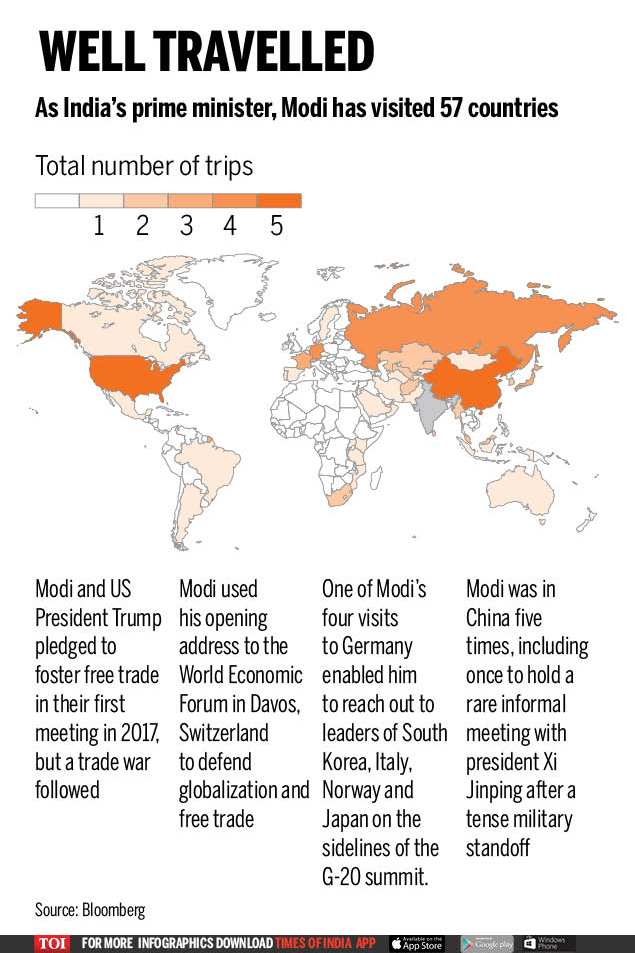
From: Bloomberg, May 1, 2019: The Times of India
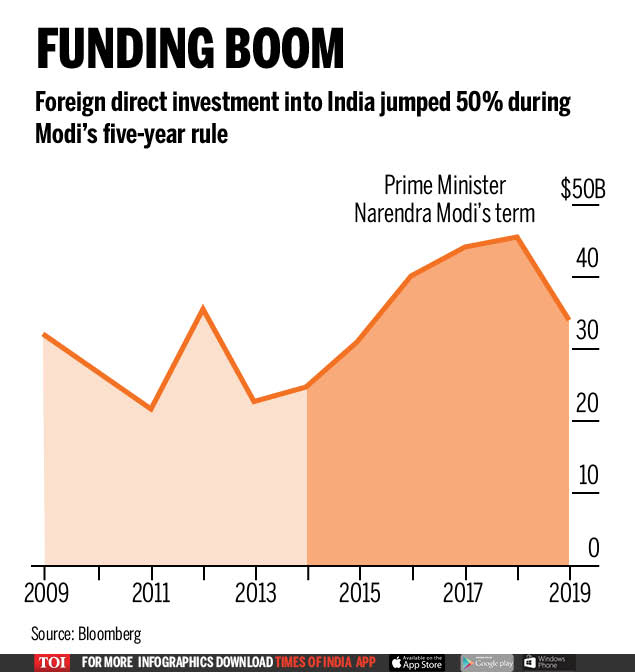
From: Bloomberg, May 1, 2019: The Times of India
92 trips, 57 countries: What PM Modi achieved on his foreign visits
NEW DELHI: As Prime Minister Narendra Modi bids for re-election, his party has said his skillful diplomacy on the world stage has increased India's global stature and brought in a flood of investment.
But what exactly have PM Modi's foreign travels achieved? With 92 trips to 57 countries since coming to power in May 2014, Modi has flown abroad nearly twice as much as his predecessor Manmohan Singh in five years.
While Modi's visits have won praise from supporters for boosting India's global profile, the costs associated with them — and the optics of traveling abroad so often in a country where many farmers are struggling — have triggered some criticism. Congress president Rahul Gandhi has accused Modi of ignoring problems at home.
A closer look at Modi's trips show that while some have yielded vague agreements that may not develop into anything substantial, doubters may still be exaggerating the negatives. Summit meetings accounted for roughly a third of Modi's visits. And his arrival in each foreign capital made a symbolic statement about New Delhi's world outlook.
Modi also made a point of repeatedly meeting leaders such as Japan's Shinzo Abe and Russia's Vladimir Putin, whose countries provide much-needed industrial investment and defense technology.
Here's more:
Record FDI
Foreign direct investment into India in Modi's first term amounted to $193 billion, 50 percent more than the preceding five years.
At the same time, despite a high-profile push to generate jobs through manufacturing, much of the FDI has continued to flow into India's services and capital-intensive industries, not labor-intensive ones.
While Modi won investment commitments from longstanding economic and strategic rival China, it largely remains a non-starter. FDI from China totaled $1.5 billion in the four years to March 2018, data from India's central bank show, against $20 billion President Xi Jinping promised in the five years from 2014.
Energy security
Under Modi, India started purchasing crude and liquefied natural gas cargoes from the US for the first time. In the last five years, he struck deals from Russia to the Middle East securing oil assets for India. He got the world's biggest oil exporter Saudi Aramco to agree to invest in India's largest oil refinery, and the UAE to fill up strategic oil reserves, reducing the strain on state finances.
More broadly, Modi has maintained relations with Gulf countries crucial to India's energy security even as he strengthened ties with Iran. However, the opposition has criticized the prime minister's diplomacy for failing to win continued access to cheaper Iranian crude in the face of increasing US pressure on Tehran.
Big projects
Modi has tried to tap a number of countries for strategic projects, which has occasionally brought him political grief.
After making the first-ever visit to Israel by an Indian premier, Modi has continued to seek advanced defense and water technology from Tel Aviv. With Japan, India is building a bullet train in Modi's native state Gujarat — although the slow pace of land acquisition has led to criticism.
In 2016, Modi signed an $8.7 billion deal for 36 Rafale fighter planes from France. The move has come under intense scrutiny since then for alleged rule violations, which his government has denied. Opponents have continued to use the deal to question the government's anti-corruption credentials.
Soft power
Modi has tried to use his trips to bolster India's global image as an investment destination and a rising global power. He's addressed the World Economic Forum in Davos and the Shangri-La security dialogue in Singapore.
Modi used a rare informal summit with China's Xi in the city of Wuhan last year to patch up geopolitical tensions between New Delhi and Beijing following a military stand off in the Himalayas.
However several trips, including a surprise visit to Pakistan in 2015, did not yield any tangible results. And though Modi has approached diplomacy with vigor, some analysts suggest he has not injected the resources — or implemented the reforms — necessary to improve India's standing in the world.
Pakistan policy
Sep 3, 2019: The Times of India
Surgical strikes to Article 370, Modi govt rewrites stale India-Pak script
NEW DELHI: For long, India's response to a major terror strike inspired and backed by Pakistan was largely to suspend dialogue and launch a diplomatic offensive. At the other end of the scale was the threat, rarely invoked, to use military might as after the attack on Parliament in 2001. The 2001-02 military standoff lasted months and ended with a ceasefire agreement and later a joint statement where Pakistan pledged not to let its territory be used for terror against India. Though Pakistan has breached the pledge often, the muscle flexing did force some concessions from Pakistan's then ruler Gen Pervez Musharraf.
But massive military mobilisation is cumbersome and expensive and cannot be frequently repeated. Soon, Pakistan got back to its routine - waiting for the storm to blow over and international pressure to build on "nuclear armed" neighbours to resume talks. India's reluctance to use force after the 26/11 Mumbai attacks reinforced this belief in Pakistan's elite circles. India was left oscillating between an ineffective suspension of a stuttering dialogue and threat of war. There did not seem any effective measures between these opposing points on a strategic scale. The situation changed with the Modi government resorting to the 2016 surgical strikes which brought home to the military brass in Rawalpindi that infiltrating terrorists into Jammu & Kashmir will not be without costs. Pakistan denied the strikes occurred, but local reports, including an audio sting of the local police head, made it clear that many jihadis waiting on launch pads had died. The 2019 Pulwama attack led to the Balakot strike and while Islamabad again denied the Jaish-e-Mohammed camp was hit, prolonged closure of its air space indicated that the possibility of IAF striking targets deep in Pakistan had induced a worrying sense of uncertainty. Though Indian planners may not have specifically considered it, the Modi government's actions seem to draw a leaf from the "compellence doctrine" articulated by Nobel winning economist Thomas Schelling which outlines actions to proactively change status quo instead of the more passive deterrence. Innovative diplomacy in West Asia with Saudia Arabia and the UAE drawn into closer ties are other, more conventional, aspects of Indian policy to contain Pakistan whose leaders lament the indifference of Muslim states to developments in J&K. The decision to turn Article 370 into a dead letter is the Modi government's boldest and most significant step and one that Pakistan cannot ignore. It now finds itself in the unusual situation of scrambling to react - a change from the past when it brazened it out. Pakistan has, apart from a major campaign on "human rights" in J&K, raised the nuclear scenario to gain global attention. This has been a familiar recipe too though the incongruity of raising the spectre of atomic weapons in response to alleged human rights violations might escape Pakistani PM Imran Khan. While India has not changed its nuclear no first use posture, a stance that marks it as a responsible nation, defence minister Rajnath Singh's suggestion that NFU is not cast in stone gives Pakistan's military more to chew on. It is another inflexion point in a battle of nerves. From hints that NFU is not sacrosanct to plans to use Indus waters (without breaching the water sharing treaty) are intended to make Pakistan bear the consequences of its rogue actions. It's a new experience.
Gifts given by Mr Modi
2022
May 5, 2022: The Times of India
New Delhi: On the sidelines of the 2nd India-Nordic Summit in Denmark’s capital city Copenhagen, Prime Minister Narendra Modi gifted decoration objects that depict India’s rich and diverse traditions.
Modi gifted a silver Meenakari bird figure from Varanasi to Crown Princess of Denmark, Mary. The most distinguishing element of Banaras Meenakari is the use of pink colour in various shades on various products. The art of silver enamelling practised in Varanasi is almost 500 years old. It has its roots in the Persian art of Meenakari.
He gifted a Rogan painting from Gujarat to Denmark’s Queen Margrethe. Rogan painting is an art of cloth printing practised in the Kutch district. In this craft, paint made from boiled oil and vegetable dyes is laid down on fabric using either a metal block (printing) or a stylus (painting).
He gifted a brass Tree of Life from Rajasthan to his Finland counterpart, Sanna Marin. It symbolises the development and growth of life. The branches of a tree grow and develop upwards and contain various life forms representing inclusiveness.
PM Modi presented a Dokra boat from Chhattisgarh to the Crown Prince of Denmark. Dhokra (also spelt Dokra) is a non–ferrous metal casting that uses the lost-wax casting technique. This sort of metal casting has been used in India for over 4,000 years.
The PM of Sweden was presented with a Pashmina stole in a papier mache box. A symbol of luxury and elegance, Kashmiri pashmina stoles have been treasured for their rare material, exquisite craftsmanship and reminiscent designs since time immemorial. Modi gifted a wall hanging with Kutch embroidery to his counterpart from Denmark.
He gifted Dhaal with Koftgiri art from Rajasthan to PM of Norway Jonas Gahr Støre. Tarkashi (Koftgiri) on metal is a traditional art of Rajasthan and is used as a means of decorating arms and armour.
Goa
A special connection
Murari Shetye , Sep 21, 2019: The Times of India
Goa, it seems, is something of a ‘lucky charm’ for Narendra Modi. From the post-Godhra days to being named BJP’s PM pick for the 2014 Lok Sabha elections, the state has always been special for him. So, on Friday, when his government decided to give its fourth booster shot to a tottering economy, it chose Goa to announce the raft of far-reaching and bold economic reforms aimed at steering the country back on to the growth path.
Modi’s connection to Goa goes way back to April 2002. At the BJP national executive meet held in the aftermath of the post-Godhra riots, Modi, then the CM of Gujarat, overcame stiff opposition from party members and the then PM Atal Bihari Vajpayee to retain his post. And, months later, he led his party to a series of spectacular successes that made him the prized vote-catcher for BJP.
It was 11 years later in Goa again that Modi emerged victorious as the party decided to appoint him as the election campaign chief for the 2014 general elections, paving the way for him to lead BJP to a thumping majority at the Centre.
“Goa has a very special place for me. This is the same Goa that allowed me to continue to serve Gujarat in 2002,” Modi had said after being appointed the party’s election panel chief in 2013. On both occasions, Goa had a BJP government under the late Manohar Parrikar, who openly supported Modi.
Modi’s first official visit outside the national capital after taking over as PM in 2014 was again to Goa, when he laid the foundation stone for the third Mandovi bridge. And it was again from Goa in 2016 that Modi, in an emotional address, made his position clear to the nation in his first comments post-demonetisation.
As Modi had said: “When I got the blessings of Goa, I was able to scale new heights.” He would be hoping now that the slew of announcements made in Goa would allow him and his government to tide over the economic crisis.
2006-11: Economic links with China [as CM]
Modi found China when blocked by great visa wall
Kapil Dave,The Times of India May 14, 2015
Prime Minister Narendra Modi's bond with China dates back to his days as the chief minister of Gujarat. China was one of the first countries Modi visited after he was denied visa by the US in 2005. In November 2006, Modi embarked on a five-day trip to China, visiting Beijing and Shanghai apart from the special economic zones in Shenzhen and Pudong.
Among the important MoUs signed during his visit was the one with China Light & Power Company, which has set up a 600MW gas-fired power plant in Paguthan in South Gujarat. The company is planning to establish a 2,000MW coal-fired plant at the same location.
However, many MoUs, such as the one establishing the sister-state relationship with Tianjin province, never took off. Talks of a technical tie-up between the Three Gorges Dam authority and Gujarat's Sardar Sarovar Narmada Nigam did not make much headway either.
Five years later, when Modi visited China again, he was accorded the treatment reserved for heads of state or national government: he was, for instance, received at the Great Hall of People. Travelling with Modi were his favourite bureaucrats like K Kailashnathan (who has been the chief principal secretary in the Gujarat government since his retirement in 2012); and A K Sharma, who is now with the PMO. The delegation also comprised top representatives from Reliance, Essar, Adani, and Shell Hazira.
Since then, China's TBEA has begun operations in the state and plans a Rs 2,500 crore infusion for a Green Energy Park in Karjan near Vadodara.
The China-India Trade and Investment Centre estimates that Chinese companies may invest about $1 billion in sectors like electronics and infrastructure in the coming years. According to industry sources, investment commitments made by Chinese companies in Gujarat is to the tune of around Rs 10,000 crore, most of which was pledged when Modi was the CM. The actual investments could be around Rs 1,000 crore, most of it in the power equipment sector.
In 2011, many MoUs were signed with Chinese entities; most have not materialized. These plans included: telecom giant Huawei setting up a manufacturing base in the state; and a tie-up between Shanghai Institute for Contemporary Development Studies for International Enterprises and a university in Gujarat. The state wanted to consult the Shanghai (Yangshan) Deep Water Port authority for technological options for the Kalpasar Project, but progress hasn't been achieved. Gujarat is a heavyweight in the port sector and has immense potential.
NDA government (2014- )
6 Milestones
May 24, 2019: The Times of India
5 Years In 6 Milestones
MANN KI BAAT
Prime Minister Modi began airing his Mann ki Baat from October 2014, in the form of a monthly radio show even as he stayed away from addressing any press conferences during his tenure. It had, among its highlights, a joint address with US President Barack Obama, who was India’s chief guest for the R-Day parade, in January 2015
SURPRISE PAK VISIT
The PM stunned all with a surprise visit to Pakistan that he announced at the last minute, through a tweet, on his way back from Kabul in Dec 2015. It also happened to be the wedding day of Pakistan PM Nawaz Sharif’s granddaughter and the presence of the Indian PM raised hope of a new beginning in peace ties between the neighbours
UN SPEECH... TO YOGA DAY
In a landmark speech delivered in Hindi at the UN General Assembly in Sept 2014, the PM spoke of, among other things, global recognition of yoga through a Yoga Day. India’s draft resolution was adopted and June 21 was declared as International Yoga Day by the United Nations in 2015
DEMONETISATION
The most controversial decision of the Modi era came through a sudden announcement by the PM in November 2016 that all Rs 500 and Rs 1,000 currency notes were being banned overnight. It led to weeks of long queues at ATMs as people struggled to exchange notes. The Opposition called it a scam, the govt said it was needed to eliminate black money
SWACHH BHARAT
The Modi govt’s most successful programme, praised worldwide, saw the govt aggressively build toilets to stop open defecation in rural areas and improve waste management in cities to stop littering. The Swachh Bharat rankings introduced the competitive edge. The result is cities like Indore, which have transformed
SURGICAL STRIKES AND BALAKOT
The Army’s surgical strikes in PoK after the 2016 Uri attack and the air strike on the JeM camp in Balakot this year marked a paradigm shift in India’s attitude towards terrorism triggered from across the border. The bold moves sent the message that the threat of N-weapons wouldn’t come in the way of India acting against terror targets in Pakistan. They also established Modi’s decisive leader credentials
Obsolete laws repealed
The Times of India, May 19 2016
Vishwa Mohan
The Narendra Modi government may be facing the opposition hurdle in Rajya Sabha in enacting certain new laws, but its record of getting obsolete and redundant laws out of the statute book appears to be moving ahead without too much fuss.
Successive governments had repealed 1,301 such outdated laws in 64 years. But the present government has managed to weed out as many as 1,159 obsolete laws in less than two years.
Obviously , the oppositiondominated Upper House too had played its part when it passed those bills concerning repeal of the 1,159 central laws, including two dozen of them from the British era, that had lost relevance long ago due to enactment of other related laws, incorporating provisions of the earlier Acts, over the years.
RS had passed two such bills, repealing 1,053 Acts, during the recently concluded Budget session. While the passing of one -Appropriation Acts (Repeal) Bill 2015 -could repeal 758 old appropriation acts, the other one -Repealing and Amending (Third) Bill, 2015 -could weed out the other 295 Acts.
Laws on licence to kill and capture of wild elephants in certain circumstances, segregation and medical treatment of lepers, regulating the grant of titles to qualified persons in western medical science, prohibition of pledging of labour of children (child slavery), regulating recruitments of foreigners during pre-Independence period, agreement with Pakistan on exchange of prisoners, continuation of use of courts in Bengal, Assam and Punjab for those who migrated to Pakistan and power to regulate prices of newspapers are among others Acts which have been repealed.
There had been many more laws in the statute books which had been of no use as provisions of most of the old Acts had already been incorporated in new legislations.
Welfare schemes
Rajeev Deshpande, May 24, 2019: The Times of India
How A Right PM Took Left Turn
To knock the wind out of suit-boot jibes levelled at him by rivals, Narendra Modi has rolled out welfare scheme after scheme aimed at uplifting the masses
Prime Minister Narendra Modi was on his way to address a poll meeting when he saw a news alert pop up on his iPad about Congress president Rahul Gandhi claiming that the Supreme Court had endorsed his allegations about Modi’s personal complicity in alleged corruption in the Rafale deal.
The PM promptly told his aides the claim needed to be robustly countered, and soon the BJP’s aggressive rejoinder was out on social media and TV screens.
Modi went on to deliver a long speech focused on the themes of development and national security which he felt were relevant to constituencies he was addressing, without making a mention of the issue that would end up embarrassing the main challenger. It was not an omission though, as he asked about the BJP’s response as soon as he finished speaking. The attention to detail and the skill to compartmentalise matters was typical of the energetic campaign the PM ran, slogging through long days that typically began by sending emails to staffers and aides around 5.30am, often setting the agenda before some of them had risen. This is around the time Modi scanned social media, checking the popular pulse and picking up clues that could become sharp political points.
Officials and political aides who work with the PM find the pace scorching as Modi seems to multi-task with ease, switching between political and official work. After his pre-dawn yoga, the PM’s focus in recent weeks has been political. He’s often passed on assessments and surveys or specific points relating to a particular Lok Sabha seat to relevant individuals in the BJP for feedback. A team that has worked with Modi since he was Gujarat CM has come to respect their boss’s sixth sense of what might become a political issue – either a weapon of offence or one that needs defusing.
Looking back to the early days of his prime ministership, a key decision Modi took was not to discontinue programmes like MNREGA which he had criticised as money sunk into pits. Similarly, Modi did not roll back the Food Security Act despite criticism that making 67% of the population as beneficiaries would be expensive, wasteful and almost take the focus away from those who actually needed the scheme.
Having drawn lessons from BJP’s ill-fated 2004 Shining India campaign, Modi did not want to give those waiting to daub the party as pro-rich a chance to say “we told you so”. MNREGA was made more accountable through geo-tagging and more importantly, its payment scheme was reworked to eliminate leaks and ensure faster direct disbursals. Despite making it a flagship programme, UPA barely launched the scheme. The Modi government ensured all states rolled out the FSA and looked to add more commodities to PDS. This was a hint of the welfare agenda he would soon roll out.
Asked if he’s proved critics – who expected social welfare programmes to shrink given the right-wing belief in markets as more efficient solutions – wrong, Modi says anyone who followed his record as CM would have known better.
LAYING THE AADHAAR
Recognising financial inclusion as the key to improving living standards, Jan Dhan accounts were an early initiative. In discussions with officials, Modi had a simple directive – keep the application form simple, no more than one page. Public sector banks led by SBI were the main vehicle of delivery, with the deposits now touching Rs 1 lakh crore. Not surprisingly, private banks lag state-owned ones by a wide margin.
Modi’s ability to dive into the implementation aspects of programmes and his receptiveness to ambitious targets makes him a bit of a policy wonk. But he doesn’t lose sight of the link between political objectives and governance and does not see it as an academic exercise. Modi’s big programmes like Jan Dhan, Swachh Bharat, Ujjwala, Ayushman Bharat, PM Awas Yojana and even Pahal (the give-up subsidy scheme) are marked by a strong focus on implementation through technology platforms like Aadhaar. The UID programme, hit by infighting in the UPA government, has been a cornerstone of his government’s success in ensuring the right people get the benefits of welfare programmes. The direct transfer element means a substantial reduction of intermediaries and leaks and therefore less corruption, adding up to savings of possibly Rs 9 billion.
REAPING THE BENEFITS OF MSP HIKE
The political prompt behind the decision to increase minimum support price (MSP) to 1.5 times of costs and the Rs 6,000-a-year transfer to farmers is clear enough. The income support came after farm distress was seen to have played a role in ousting long-running BJP governments in Chhattisgarh and Madhya Pradesh and ensuring the party’s exit in Rajasthan. BJP leaders believed that rather than distress factors like drought, the key issue was low prices for farm produce. Growth in farm incomes could not match urban centres and disparity in lifestyles had also become a bone of contention.
The MSP measures had been in the works months before the 2018 winter assembly elections but were seen as slow in taking effect. Income support was seen as doable – again on the back of direct transfers into bank accounts – and the results were evident as the campaign unfolded. Several beneficiaries received two rounds of payments and Oppositionruled states that did not provide lists of eligible farmers were accused of denying funds to agriculturists. The welfare programmes directed at the poor had a potent political element. They were intended to make BJP the party of choice among a section of electorate that has viewed regional parties with caste and populist agendas and the Congress – with its rights-based approach – with favour. BJP was often seen as an urban party with a North Indian orientation. Its rise after the Ayodhya agitation also led to it making inroads among backwards and Dalits, but these influences tended to be passing. Hindutva helped make BJP more than an “upper-caste and trader party”, but parties like Samajwadi Party and Bahujan Samaj Party halted the consolidation.
The 2014 election saw a significant section of the poor voting for Modi, persuaded by his “chaiwala” pitch and earthy appeal. They were also angered by the high inflation of UPA years. As PM, Modi understood the need to bind this constituency to the BJP and set about snatching the “pro-poor” card from the Congress. The initiatives to build toilets and houses, deliver cooking gas, old-age pensions and power connections and the PM Kisan transfers helped convince this big and decisive section of voters that Modi was their man. The programmes, along with other initiatives like the mission mode Gram Swaraj Abhiyan, helped establish the PM’s credibility among the under-privileged.
NOTEBANDI: RISKY BUT GOOD POLITICS?
The impact of demonetisation is still hotly debated and was perhaps the riskiest political move in Modi’s first term as PM. It was intended to be a shock to the system and a dramatic measure to attack circulation of black money. Its exact economic fallout has proved hard to map as it was soon followed by another disruptive measure – the introduction of GST. The November 8, 2016 announcement, despite the immediate hardships and sudden shrinkage of daily wage-linked work, proved a political success. It was seen to have seriously discomfited the rich and perceived as being ordered by a leader who was above black money politics himself.
There was a vicarious delight in tales of those with large cash hoards scrambling to dispose of currency and instances of domestic help and other employees being given months of salary in advance.
Success in the 2017 Uttar Pradesh elections, as also BJP’s win in Delhi’s municipal polls, were seen as vindication of notebandi. Despite the return of almost all denotified currency, demonetisation paid off as Modi came across as a leader prepared to take on vested interests. The absence of any widespread violence and relatively swift re-monetisation helped avert political damage. Notebandi supplemented the welfarist approach in securing a broader social coalition for the BJP, with the inclusion of sections that had traditionally aligned with its rivals.
FOREIGN FLAIR
Along with positioning himself as a leader who could think big and deliver on time, Modi’s challenge was to ensure the government’s credentials on national security remained intact. He did so by showing a flair for foreign policy that surprised commentators. He displayed a keen eye for economic partnerships but built strategic relations with the US, Germany, UK, France, Saudi Arabia, UAE, Australia and Japan. This was vital in ensuring India did not get isolated in its differences with difficult neighbours Pakistan and China. After initial attempts at restarting dialogue, Modi seemed to realise Pakistan was going to be his principal international and domestic challenge.
The first hint of a pro-active military strategy came with the cross-border strikes against NSCN (K) in 2015 after 18 soldiers died in an ambush in Manipur. The surgical strikes against terror launch pads in Pakistan-occupied Kashmir followed the next year after 19 soldiers died in a Jaish-e-Mohammed attack on an Army camp in Uri. Though denied by Pakistan, the operation gave a boost to the PM’s image as a doer who had called the rogue neighbour’s bluff. The airstrikes on the JeM camp in Balakot in Pakistan were a much bolder operation, with a large force of Indian Air Force jets crossing the LoC for the first time. The absence of any support for Pakistan barring Turkey, and the US backing of India’s right to selfdefence dented Islamabad’s nuclear blackmail.
The Balakot airstrikes quickly percolated to the grassroots. The popular view was that Modi had broken a pattern of defensive responses. The PM used vigorous references to the strikes – “Ghar mein ghoos ke mara hai” – to contrast his government’s measures to the unpreparedness of UPA to hit targets in Pakistan. The argument played well with both urban and rural opinion tending to see national security as a primary requirement.
With the strikes proving a tonic, the Pakistan-bashing theme tied in with BJP’s attack on the Opposition for seeking “proof” of damage to the Jaish camp. Painting the opposition as “pro-Pakistan” sat close to BJP’s more usual charge of “appeasement” as Modi and other senior leaders accused Congress of catering to vote banks. The clamour likely buried Congress’s attempts to raise the Rafale deal as a likely corruption issue with BJP trumpeting that neither graft nor inflation had become a pain point in the election. Cultural issues such as beef bans and the rise of assertive Hindutva could have been a trip wire for Modi. There was a delay in reacting to the Dadri lynching in 2015 though the PM then followed up with repeated warnings that no one should take the law into their hands. Cases of cow vigilantism attracted wide attention and saw several campaigns such as “award wapsi” and “not in my name” becoming the fulcrum of the “intolerance” movement against Modi. The charge that his rise encouraged militant Hindutva elements affected a section of middle-class sentiment bothered by what it saw as a coarsening of society.
Yet the political damage could have been more but for BJP seizing on incidents such as the controversial attempt to observe the “martyrdom” of Parliament attack convict Afzal Guru at JNU by a section of Left and far-Left students. BJP swiftly turned this into a “nationalist” cause, accusing Congress of backing the “tukde-tukde gang.” This, along with a broader rise of Hindu identity, worked to the BJP’s benefit as its state governments made “gau raksha” a major part of their programmes even as a stray cattle problem almost upset the BJP applecart in UP.
The cultural battles saw BJP push for a more unabashed Hindu flavour to its articulation while seeking to corner opponents as those whose arguments echo Pakistan. Is the Opposition ganging up only to eject Modi who ordered airstrikes on Balakot? This was the question Modi repeatedly asked in his rallies.
He captured the popular imagination despite the contentious debate on jobs in the midst of major initiatives like GST and related laws intended to force failing companies to either cede control to new owners or accept a dissolution process. As claims on employment flew thick and fast, the government found itself accused of not releasing unflattering data on joblessness. It argued that spending on infrastructure, schemes like Mudra and the new economy were generating jobs.
The debate is far from settled, but Modi’s projection of a more hopeful future – along with his welfare approach – caught the imagination of voters who tended to see the opposition, particularly Congress, as tainted by corruption scandals. In his campaign, Modi insisted his record should be compared to UPA and kept the focus on Congress’s record of graft scandals. Congress sought to turn the tables through Rafale allegations, farm distress and jobs, but failed to trump Modi’s formidable credibility with voters.
His key words

From: May 24, 2019: The Times of India
See graphic, 'PM Modi’s Key Words '
2015- 2025 September
Sep 17, 2025: The Times of India
Modi’s Politics
By 2014, coalition politics appeared the norm. Modi broke that trend, leading BJP to a majority in a contest that became a referendum on him. He was the first to do so since Indira Gandhi in 1980 (Congress’s win in 1984 was not because of Rajiv Gandhi, but a sympathy wave). An encore followed in 2019. His third term, even without a full majority, looks remarkable considering the global trend of incumbents struggling post-Covid.
More than just numbers, Modi’s influence lies in reshaping the political landscape. He gave unprecedented legitimacy and geographic spread to Hindutva, framed politics as “seva”, and pushed an all-consuming mission-driven governance model. Even opponents acknowledge, often with alarm, his transformative impact. His constant pursuit of goals has forced rivals to recalibrate. India is in a very different place than it was in the pre-NaMo days, and reversing the changes wholesale is unlikely, if at all.
Article 370
The abrogation of Article 370, ending J&K’s special status, fulfilled a decades-old BJP objective. The stealthy, bold strategy surprised many and was a masterclass in political manoeuvring — especially in pushing it through Rajya Sabha without clear numbers. In the process, Modi and his lieutenant Amit Shah demolished several assumptions: the indispensability of separatist Hurriyat, fear of stone-wielding mobs that controlled the streets in the Valley, the compulsion to have dialogue with the backers of terrorists, and a hostile global response which had guided the handling of the Kashmir question by preceding regimes.
The post-abrogation management was crucial: elections widely seen as fair, a drop in terrorism and local recruitment, and rising tourism and infrastructure. The 2024 Lok Sabha elections in J&K, conducted after a long gap, had a turnout of 58.6%, the highest in decades. Despite the Pahalgam terror attack, overall violence indicators have declined. The promise of restoring statehood remains unfulfilled, but there’s visible public support for the developmental dividend.
Operation Sindoor
Though the lustre of its achievement was dulled somewhat by the noise over “ kitne Rafales gire ?”, Operation Sindoor was PM Narendra Modi’s response to the massacre of tourists at Pahalgam by fanatical fundamentalists. It marked India’s entry into ‘new-age warfare’ and signalled readiness for the risks and challenges such warfare entails.
There is now near-consensus that the military response to Pakistan’s perfidy was a resounding success. International experts were the first to applaud, and even sceptical domestic commentators have largely come around. The no-contact war, enabled by precise intelligence and marked by jointness across services, scored major hits: terror HQs were razed, Pakistan’s air defence was crippled, and key airfields were taken out — leaving the hostile neighbour exposed to Indian jets. In contrast, Indian air defences held firm.
But the operation’s significance runs deeper. It built on the surgical strikes and Balakot air raids to call out Pakistan’s nuclear bluff. It asserted India’s readiness to act under a nuclear overhang, ignoring the panic buttons often pushed in Western capitals. In short, a ruthless assertion of strategic autonomy. It also prepared Indians to accept the cost of future high-stakes action.
Covid Vaccination
India’s Covid vaccine strategy centred on domestic manufacturing. Covaxin and Covishield were rolled out rapidly, with Modi pushing for development and trust-building.
Over 220 crore doses were administered by Jan 2023. Around 97% of eligible adults got at least one dose, 90% both — among the world’s best vaccination coverage. Rural penetration was especially impressive. The CoWIN platform helped schedule and verify millions of doses daily.
GST & Tax Reforms
A critic of the model floated by UPA, Modi embraced the Goods and Services Tax and drove its rollout in July 2017, subsuming 17 state and central levies. A unique federal body, the GST Council, now decides indirect tax rates. It marked the creation of a true “one nation, one tax” system.
The tax base has more than doubled to over 1.5 crore. Cascading effect of taxes is gone, and rates have been streamlined. The GST Council slashed rates on 375 items and reduced slabs to three — 5%, 18% and 40%. Corporate and personal income tax have shifted to easier, exemption-free regimes, incentivising formalisation. A simplified Income Tax Act is due in April 2026.
Insolvency And Bankruptcy Code
IBC, long in the works, was passed under Modi and gave banks a powerful tool to recover bad loans. Around 1,200 major cases (worth Rs 12 lakh crore) were settled directly under IBC, and 30,000 more (worth Rs 14,000 crore) due to creditors invoking it. Gross NPAs dropped from over 9% in 2021 to 2.6% in 2025. Beyond numbers, IBC shifted borrower behaviour: firms now fear losing control, making them more likely to settle dues early. Bank mergers and IDBI’s planned privatisation are part of the banking sector revamp. The sector now appears more resilient.
Aadhaar
Launched in 2009, Aadhaar scaled dramatically under Modi and became central to India’s Digital Public Infrastructure (DPI). Over 1.4 billion IDs cover over 95% of the population. It has helped transform the digital landscape from payments to healthcare and financial inclusion. Combined with Jan Dhan accounts and mobile phones (JAM trinity), Aadhaar enabled seamless benefits, identity-based services, and massive savings. It underpins everything from LPG subsidies and UPI payments to DigiLocker, vaccination platforms like CoWIN, and more. DPI now defines India’s digital transformation and inspires replication in Africa, Latin America, and South Asia.
Jan Dhan & Social Security
Modi’s 2014 Jan Dhan Yojana aimed to open bank accounts for all. Within five months, 12.5 crore accounts were opened. Today, over 56 crore accounts hold Rs 2.6 lakh crore.
These accounts enabled targeted benefits, reduced leakage, and powered Direct Benefit Transfers (DBTs). During Covid, Jan Dhan served as the backbone for mass financial aid. They now support schemes like PM SVANidhi (for street vendors) and PM Jeevan Jyoti Bima Yojana (insurance), and allow street vendors and daily wagers to operate digitally. It has helped expand UPI too because vegetable sellers, barbers and auto drivers now rely on digital payments, reducing the need for cash transactions in the economy.
UPI (Unified Payment Interface)
The world’s largest real-time payment system, UPI, crossed 20 billion monthly transactions in Aug. While the scale-up of the platform was extremely rapid, the support system for UPI was first laid with the launch of the Pradhan Mantri Jan Dhan Yojana (PMJDY) in 2014 which was alongside the aggressive rollout of Aadhaar. These two developments coupled with the extensive rollout of mobile telephone put in place the JAM (Jan Dhan Aadhaar and Mobile) trinity which provided the framework for the rollout of UPI. While NPCI built the platform, its adoption surged post-demonetisation in 2016. Modi promoted it directly, launched the BHIM app, and linked it to a digital India push. JAM groundwork, QR familiarity via wallets, and pandemic restrictions enabled UPI’s explosive growth. From large retailers to vegetable vendors, digital payments are now universal.
Food Security
The PM Garib Kalyan Yojana transformed food subsidy into the world’s largest free foodgrain scheme. Over 80 crore people now get 5 kg rice/ wheat per month free.
Though the food security scheme to provide 5 kg foodgrain at a very subsidised price was rolled out during the fag end of UPA-II, it was fully implemented after 2014. The real impact of the scheme having a wide network of over 5 lakh ration shops was felt during the Covid pandemic when the govt offered 5 kg extra wheat and rice to beneficiaries free of cost in addition to the same quantity they were receiving by paying Rs 2 and Rs 3 per kg, respectively.
Ayushman Bharat
Providing health insurance in a country with a billion-plus population, a federal polity and challenges of underdevelopment and corruption was a leap of faith. Modi govt launched Ayushman Bharat in Sept 2018, the world’s largest free healthcare insurance scheme, providing a coverage of up to Rs 5 lakh per family annually, for secondary and tertiary care hospitalisation. Initially for the poor, it now covers all citizens aged 70+.
So far, 42 crore people are enrolled, and 9.5 crore hospitalisations have been covered across nearly 33,000 empanelled hospitals. A Lancet study showed timely cancer care improved by 36% under the scheme. The savings on catastrophic health expenditure, especially in rural households, have been significant.
Started during Covid, PMGKAY was implemented in seven phases and for 28 months, recording a distribution of around 1,015 lakh tonnes of free foodgrain across the country. Subsequently, the govt decided to provide free foodgrain from Jan 2024 to Dec 2029, a guarantee for five years.
Besides Aadhaar-linking of beneficiaries and use of electronic point of sale (PoS) machines for foodgrain sale at ration shops, the introduction
Highways
An over two-and-a-half fold increase in pace of construction and expansion of national highways, and jump in the number of high-speed corridors, including expressways, have been the hallmark of infrastructure push over the past 11 years. Since 2018-19, annual highway expansion and construction has been over 10,000km and peaked in 2020-21 at 13,327km or 37km per day.
The length of high-speed corridors (HSC) has increased from only 93km in 2014 to nearly 5,000km now. Most of these have been built during the last six years. Similarly, the length of NHs that are of four lanes or more, excluding HSCs, has increased by 2.5 times from 18,278km in 2014 to over 46,000km. Capital expenditure on NHs has significantly increased from about Rs 51,000 crore in 2013-14 to nearly Rs 3 lakh crore now.
The introduction of mandatory FASTag in vehicles for payment of toll charges across the NH network in 2021 along with accelerated highway development has improved the ease of movement and checked leakage of toll revenue. With over 98% of toll payment transactions made through FASTag the average waiting time at toll booths has reduced by up to 93% — from earlier 714 seconds to 47 seconds.
However, upkeep and safety on these expressways is an emerging concern. Yogesh Chawda of ‘One Nation One Ration Card (ONORC)’ expanded the benefit to all, including a large share of migrant workers who come to cities for employment. This provision has ensured that no beneficiaries are deprived of their entitlement even if they shift to another state or city for work.
Jal Jeevan Mission
Launched in 2019 to provide tap water to all rural homes, Jal Jeevan Mission has covered 15.7 crore out of 19.3 crore households (81%). At launch, only 3.2 crore homes had connections.
Eleven states/UTs now report 100% coverage. Kerala, Jharkhand, West Bengal and Rajasthan remain laggards. The deadline has been extended to 2028 due to Covid and cost overruns. But in many states, JJM has dramatically reduced drudgery for women who earlier walked kilometres for water.
PM Awas Yojana
Housing for the poor in both rural and urban areas has been on the agenda of all successive govts, but it received a significant push with the launch of the PM Awas Yojana (PMAY) during 2015 and 2016 under the umbrella programme of ‘Housing for All’. Besides financial assistance for building and buying houses, the major focus was on the empowerment of women. Data shows that women are either sole or joint owners of over 70% of such houses.
So far, 3.9 crore pucca houses have been sanctioned in rural areas, out of which 2.9 crore have been completed. In the case of urban areas, nearly 1.2 crore houses have been sanctioned, and 94 lakh of these have been completed.
Though the govt had set the target for achieving ‘Housing for All’ by 2022, the scheme was extended and expanded, considering the increase in the number of eligible families seeking pucca houses in both rural and urban areas. Last year, the govt approved a plan to provide financial assistance for building 2 crore more houses in rural areas and 1 crore in urban areas by 2029. The extended scheme, involving an investment of Rs 10 lakh crore, with the Centre contributing Rs 2.2 lakh crore, also has huge potential to boost economic activity.
To meet the growing demand for affordable rental housing for people migrating to cities for jobs, the urban segment of PMAY also provides financial assistance to private developers building residential complexes for this purpose. At a later stage, individuals will be able to book affordable rental houses before relocating to a city. For this, the govt has set up an IT interface where the availability of such accommodations will be visible to potential customers, who will also be able to book them online.
Swachh Bharat
Launched on Oct 2, 2014, the Swachh Bharat Mission (SBM) has been a landmark initiative aimed not only at achieving universal sanitation coverage and making India Open Defecation Free (ODF), but also at being one of the largest interventions to bring about behavioural change. With its two verticals — SBM-Gramin for rural areas and SBM-Urban for cities and towns — the mission made its biggest achievement in Oct 2019, with all villages and towns declared ODF, a milestone that especially focused on restoring the dignity of women. So far, more than 12 crore household and public toilets have been built across the country with govt assistance. Taking sanitation to the next level under Phase II, the focus has shifted to helping villages not only maintain their ODF status but also achieve ODF Plus status by implementing systems for solid waste management and liquid Waste Management, along with ensuring visible cleanliness — minimal litter and no stagnant wastewater.
Data shows that out of 5.9 lakh villages, 4.8 lakh have declared themselves ODF Plus, and verification has been conducted in 81% of these villages. With increased focus and public participation, 5.2 lakh villages have some form of solid waste management, while 5.36 lakh villages have systems in place to manage liquid waste.
PM Surya Ghar
Launched in Feb 2024, the world’s largest domestic rooftop solar initiative has already started transforming India’s energy landscape by connecting nearly 20 lakh homes with installation of rooftop solar panels to provide free electricity. It aims to reach 40 lakh households by March 2026.
Since the scheme offers a subsidy of up to 40% to households, it makes renewable energy more affordable and accessible. Easy financing options, including collateral-free loans up to Rs 2 lakh at a 6.75% subsidised interest rate through 12 PSU banks, has already accelerated its adoption.
Once a goal of connecting one crore households is achieved, the scheme is expected to save the govt Rs 75,000 crore annually in electricity costs. As spin-offs, the transformative initiative will not only encourage millions of people to adopt clean energy but also reinforce India’s commitment to renewable energy in sync with the country’s long-term climate action goals. India has already crossed 251.5 GW (more than 50%) of non-fossil capacity of electricity.
Ujjwala
From the initial target of five core connections to provide free LPG connections to women of BPL households the number of beneficiaries has more than doubled under the PM Ujjwala Yojna (PMUY), signalling the impact of this govt initiative, which has been a key vote-catcher as well.
As of June 2025, PMUY scheme has covered little over 10.3 crore beneficiaries out of the total 33 crore active LPG customers in the domestic category in the country. To bring more needy women into this clean cooking fuel net, under Ujjwala 2.0, a special provision was made for migrant families, allowing them to avail a new LPG connection through a self-declaration instead of requiring proof of address and ration card.
The shift from biomass to LPG improved air quality and freed up women’s time. WHO studies show household air pollution has declined significantly in rural India.
A timeline
Swapan Dasgupta, Sep 17, 2025: The Times of India
THE RISE OF A TALL LEADER
1950-1985
From R S S To BJP
Narendra Modi was born on Sept 17, 1950, in Vadnagar town in Mehsana district of Gujarat, the third child of Damodardas and Hiraba. By 1972, he had joined the R S S and become a pracharak, committing himself to full-time social and political work. In 1985, he was assigned by R S S to the state BJP unit.
1985-2001
National Politics To Guj Hot Seat
In 1987, Modi was appointed general secretary of Gujarat BJP and was associated with campaigns for local and assembly elections. In 1995, BJP’s victory in elections in Gujarat was followed by Modi being named secretary of the party’s national organisation in New Delhi. He went on to become its general secretary in 1998.
In 2001, he was named Gujarat CM to replace Keshubhai Patel.
2001-2014
Four-Time Guj CM Becomes PM Modi led BJP to consecutive victories in 2002, 2007 and 2012 elections, becoming the longestserving Gujarat CM. The ‘Gujarat Model’ of economic growth and infrastructure development under his leadership became much talked about. In 2013, he was named BJP’s PM candidate for parliamentary elections the year after.
2014-2025
Face Of BJP’s Rise
BJP won a majority on its own led by Modi as NDA took office at the Centre after a 10-year gap. Modi’s first term saw the launch of Swachh Bharat Mission. He announced demonetisation banning Rs 500 and Rs 1,000 notes in 2016 while GST was introduced in July 2017. BJP won with an even bigger margin in 2019.
In his second term as PM, Art. 370 giving special status to J&K was abrogated and triple talaq banned. India launched airstrikes on Balakot in Pakistan following the Pulwama terror attack in 2019. After Covid hit, India swiftly moved to emerge as a key hub for vaccine production with a massive vaccination campaign carried out nationally.
In the 2024 Lok Sabha elections, BJP again formed the govt, this time with the backing of Nitish Kumar and Chandrababu Naidu. Modi was sworn in as Prime Minister for the third consecutive term, a feat only Jawaharlal Nehru had managed. In early 2025, terror attack in Pahalgam was followed by the launch of Operation Sindoor by Indian forces targeting terror hubs in Pakistan.
Ideology
What Narendra Modi spoke about, 2017-19
April 12, 2019: The Times of India
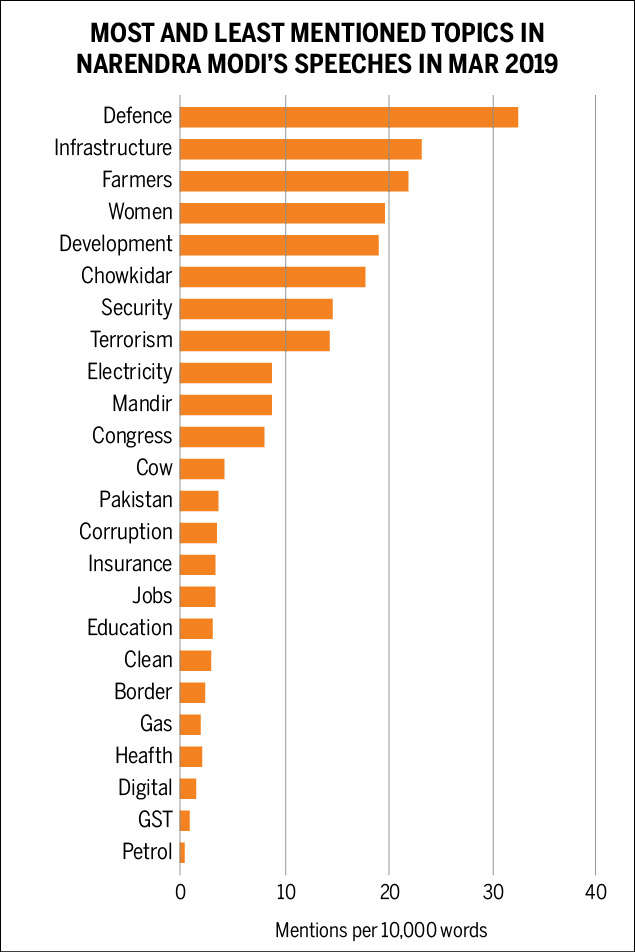
From: April 12, 2019: The Times of India

From: April 12, 2019: The Times of India

From: April 12, 2019: The Times of India
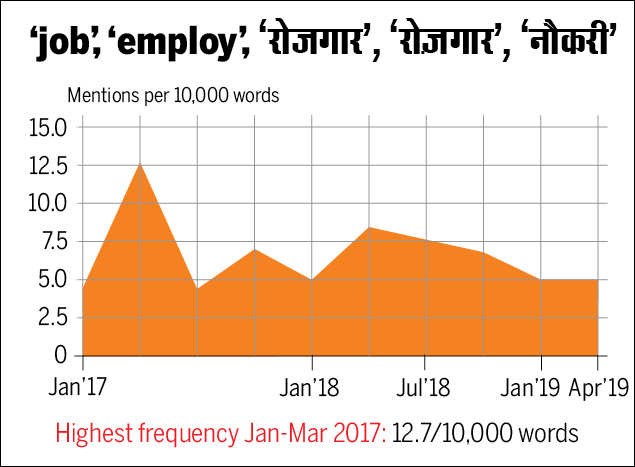
From: April 12, 2019: The Times of India
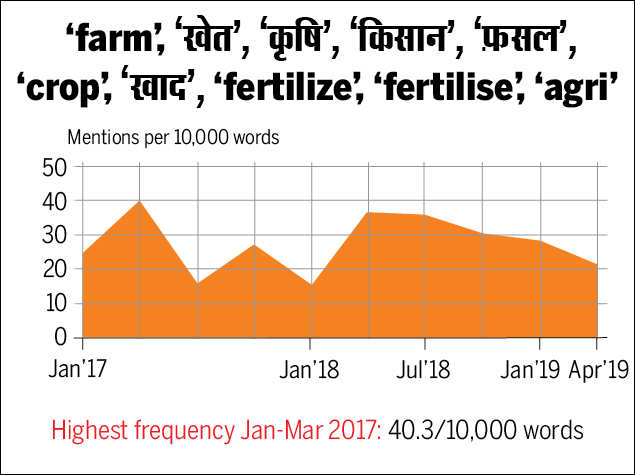
From: April 12, 2019: The Times of India
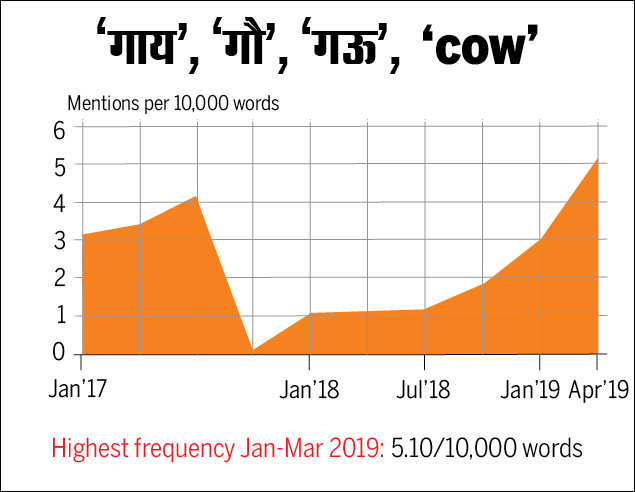
From: April 12, 2019: The Times of India
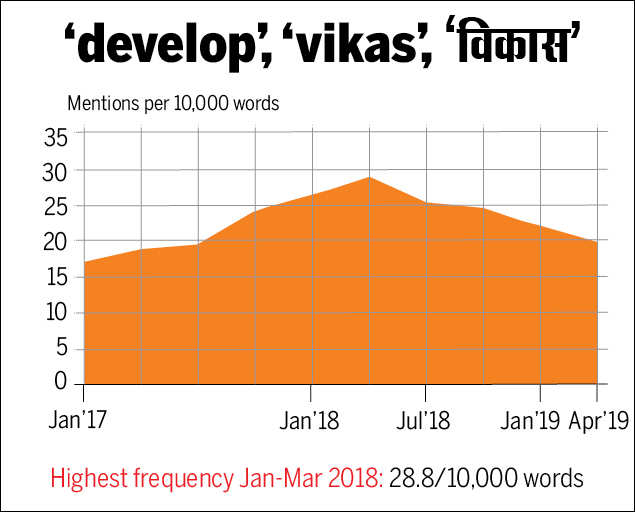
From: April 12, 2019: The Times of India
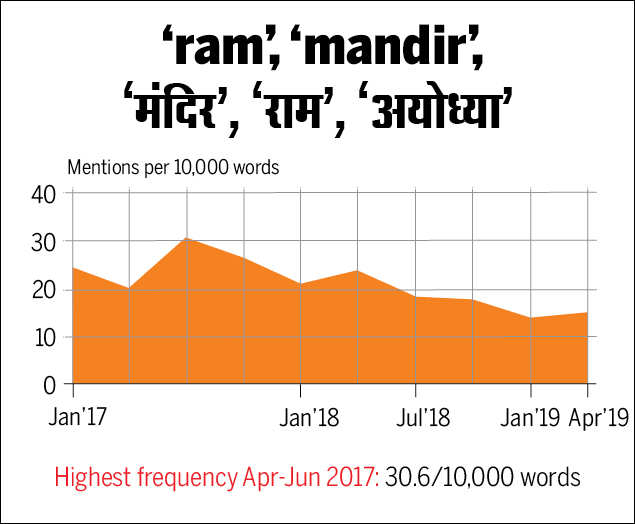
From: April 12, 2019: The Times of India

From: April 12, 2019: The Times of India

From: April 12, 2019: The Times of India
An analysis of PM Narendra Modi’s speeches in March 2019 gives insights into his election focus and what he is choosing to ignore. Right on top is ‘Defence’ — a topic that's always got high mentions, followed by ‘Infrastructure’, ‘Farmers’, ‘Women’ and ‘Development’. The topics he's choosing to steer clear of are ‘Demonetisation’, ‘GST’ and ‘Digital’. These were once close to his heart, but one month prior to the Lok Sabha polls, it appears he thinks they will not cut ice with the voter.
Going back two years, a look at the frequency of selected words used by Modi in the 553 speeches he has given since 2017, gives a sense of the broad themes he's focused upon. For instance, while the PM’s use of the word ‘chowkidar’ has peaked now; 'Pakistan', on the other hand, saw more mentions in 2017, even though Pulwama and the Balakot strike are the main focus of BJP’s push for a return to power at the Centre. Here’s more...
Chowkidar
While campaigning for the 2014 Indian general election, Modi in his speeches, promised that he would serve the country, not as a prime minister but as a watchman and never allow anyone to steal public money. In the 2017 assembly polls, Rahul came up with the “chowkidar chor hai” jibe. In 2019, Modi has sought to make the word his own by launching his " main bhi chowkidar" (I too am watchman) campaign. This poll season, the PM’s use of the word in his speeches has seen a spike.
Pakistan
The Pulwama attack and Balakot airstrike has placed security and Pakistan in prominent focus for BJP. Modi has been referring to the Pulwama attacks in his campaign speeches as well, but Pakistan has found little direct mention off late.
Rahul
Dynasty and Congress have been big targets for Modi, so it’s not surprising that Rahul would figure with some frequency in his political speeches. There has, as expected, been an increase in 2019, as polls draw closer.
Jobs
Words linked to employment found a high mention in Modi’s speeches when he became PM, but there’s been a decline visible of late.
Farmers
A theme that has seen heavy articulation since he took charge at the Centre. In Modi’s first three years, references to farmers featured high in his speeches. They have, however, dropped in the run-up to the polls.
Cows
A word the PM has used quite regularly. Not only is cattle an issue in several seats in the Hindi heartland, with the BJP campaign focus shifting to culture and heritage, mentions of cow in Modi’s speeches has risen.
Development
For someone who swept to power with the slogan of “ sabka saath, sabka vikas”, it is not surprising that development has been a preferred theme for Modi. However, in recent election speeches, mentions are on the decline.
Ram Mandir
A word that underpins a core stance of BJP, it has seen its fair share of mentions by Modi. Peak usage from the podium for this word came in the middle of 2017. With election season underway, ‘mandir’ mentions are seeing an uptick.
Defence
The PM regularly brings up the mention of ‘Defence’ in his speeches to evoke patriotism. Hardly surprising that post the Pulwama attack in February 2019 the references have surged. In fact, Modi is now under the Election Commission scanner for a campaign speech in which he exhorted first-time voters to dedicate their ballot to those who died in the Pulwama terrorist attack and those who took part in the Balakot offensive against Pakistan.
Infrastructure
With his government having initiated several ambitious infrastructure projects, particularly in the transport and electricity sectors, they find regular mentions from the podium. They peaked, though in Oct-Dec 2017.
Image recast in the USA
The Times of India, June 9, 2016
Displaying an unsentimental, hard-headed selfinterest, PM Modi wasted no time in visiting the US after assuming office, putting aside previous controversies as he grasped the importance of the bilateral relationship -and the potential for some smart image management. Not unlike his predecessor Manmohan Singh, the new PM understood that much of India's aspirations for a global role as an economic and military power would remain unfulfilled without accessing US technology and finance.
Modi managed to hit it off with US President Obama -a feat that still puzzles many (New York Times called it the most unlikely friendship Obama could have struck with any world leader) -and this was crucial to lifting ties.
The bemusement is in good measure due to the alleged contrast between Obama's commitment to minority rights and dissent and Modi's purported moorings in the “rightwing paramilitary“. But Modi side-stepped stereotypes and connected with Obama on issues like climate change and China and leveraged his big parliamentary majority .
An oped in the Washington Post last year declared that trade, investment and technology would be the bedrock of a partnership for the 21st century to harmonise India's ambitious development agenda while sustaining US growth.
In his first visit, Modi used the Madison Square event to tap overseas Indian sentiment and the enthusiastic reception was duly noted by global media. It was an effective strategy to counter activists raising human rights issues.
The PM's warm relationship with Obama was crucial for his plans to push Indian interests ranging from Pakistan, China, technology , investments, defence, climate change to admission to the NSG.
Bilateral ties with China would always be difficult, not the least because economic and military muscle gave the Chinese a sense of superiority. The US was essential to India's efforts to seek a more eq uitable deal from China.
Years of tough sanctions related to dual use technology had hurt Indian science and industry with even improving monsoon predictions becoming a labourious task in the absence of sophisticated computers and satellite data.
The relationship gained momentum under Manmohan Singh with the nuclear deal being concluded during UPA-1, but ties lost steam in his second term.
Though his win in the 2014 Lok Sabha elections -and the decimation of Congress -gave him huge legitimacy , Modi still needed to shake off the shadow the Gujarat riots cast on his career at home and more particularly abroad. Four visits to the US have helped him do that in large measure.
Threats to life: 2014-
2014-June 18
June 9, 2018: The Times of India
HIGHLIGHTS
Amid reports of a Maoist conspiracy to assassinate Prime Minister Narendra Modi, here's a look at some of the high-profile threats to the PM's life in the recent past:
Threat 1 (Oct, 2013)
Six persons were killed and several others injured when a series of blasts rocked Modi's Hunkaar Rally in Patna on October 27, 2013. Modi, then the CM of Gujarat, had helped avert mass panic and a stampede by exhorting the audience to maintain peace and unity at all costs.
Total nine bombs were planted at the Gandhi Maidan venue by terrorists owing allegiance to banned Students Islamic Movement of India (SIMI). Ten were held and charged for their involvement in the blasts.
Threat 2 (May 2015)
A WhatsApp message threatening to blow up PM Narendra Modi’s stage ahead of a rally at the ancestral village of Pt Deendayal Upadhyay to mark the first year of the BJP government sent the entire intelligence and police force in a tizzy.
Though police officials termed the threat an act of some "distorted mind", security in and around the venue was beefed up and extra vigil was mounted in the district. UP police later identified the sender of the WhatsApp message and took his brother into custody.
Threat 3 (Feb 2017)
In the run up to the UP assembly polls, a senior police official claimed threat to PM Modi’s life during a BJP campaign rally in Mau district. According to ASP RK Singh, Rasool Pati, an accused in the Haren Pandya murder case, and his associates planned to attack the prime minister’s convoy with a rocket launcher and explosives. Modi went ahead with the rally under tight security cover.
Threat 4 (June 2017)
Kerala DGP TP Senkumar claimed PM Modi faced terrorist threat during his visit to Kochi to flag off the city's new metro rail. "There was a big threat perception here on the day of the Prime Minister's visit... There was a terror module here during his visit," Senkumar said days after Modi had wrapped up his visit. When asked to elaborate on this "terror threat", the DGP refused to disclose details.
Threat 5 (June, 2018)
Pune police claimed that Maoists were planning to target Prime Minister Narendra Modi. A letter found in the house of Delhi-resident Rona Wilson, arrested for alleged Maoist "links", talks about the ultras mulling "Rajiv Gandhi-type incident" and suggesting that Modi should be targeted during his road shows.
Wilson was among five people arrested from Mumbai, Nagpur and Delhi in connection with Elgar Parishad held in December and the subsequent Bhima-Koregaon violence in Maharashtra.
Elections to the Lok Sabha
2014: General Elections
Winning India was an extraordinary achievement. A new book reminds us how Narendra Modi did it.
Kaveree Bamzai
March 27, 2015
Lance Price has written the definitive account of the campaign that got Modi to where he is now, friend of Barack and Bibi, mentor-in-residence of a young nation, and custodian-in-chief of an emerging alternative narrative of the past. Much of what he tells us is known to most journalists who reported or researched the 2014 General Election-the use of social media, the debut of 3D technology, the support of gurus such as Baba Ramdev and Sri Sri Ravi Shankar. But the star of the book, as of the campaign, is Modi, as he tirelessly recounts the relentless campaign to Price with complete lack of irony about either referring to himself in the third person or recalling his God-given gifts (among them being a sense of style).
Key learnings
Pay attention to details
Piyush Pandey talks of how Modi was his art director, often stepping in to suggest colours and designs. Nothing was too minor for Candidate Modi to pay attention to. The theme was clear and best articulated by Modi: "My campaign had to be national but my appeal had to be local to the people."
Delegate to the right people
Because Modi could not use the party machinery, he put together a collection of bright, young, committed professionals, ranging from IT specialists Hiren Joshi and Prashant Kishor to admen Piyush Pandey and Prasoon Joshi, who worked tirelessly for him.
Allow for experiments
The 'Chai pe Charcha' was abandoned after the first three times, while the 3D technology was tried a few times before it was perfected.
Never miss an opportunity to attack
The 2014 campaign was marked by the Congress handing Modi a series of prize catches-from Rahul Gandhi's toffee remark to Priyanka Gandhi's comment about neech rajniti to Manmohan Singh's achche din remark at his last press conference as prime minister. Modi didn't miss a single trick.
Never give up
As Price notes, Modi had to mount a three-step campaign-to win Gujarat in 2012, win over his party in 2013 and then India in 2014. It required patience, dedication, and never losing faith, not just on Modi's part but also on the part of all his followers. They managed because they didn't drop the ball even once.
Go big With Modi, says an aide to Price, everything had to be the biggest, the boldest, the best. Nothing less would do.
Price gives us a ringside view of Modi's way of working: how he checks his email first thing in the morning and the last thing at night. He tells us of Modi's two favourite responses to criticism-Congress lies and media distortion, in that order. He even settles the debate on how much, or how little, Modi sleeps-it is five hours.
It is when Price is analysing the future of the government that he is at his best. He quotes Arun Shourie as saying that the government had better start performing if it has to endure: "You need to act on what Buddha said: Live each day like your hair is on fire." And indeed, though Modi seems in no hurry, India is. It's when you read Price that you remember what an extraordinary campaign Modi launched to win India. Now he has to unleash similar forces for India to win the world. Or as Mario Cuomo said so famously: you campaign in poetry, you govern in prose.
2019 elections
Words used most frequently
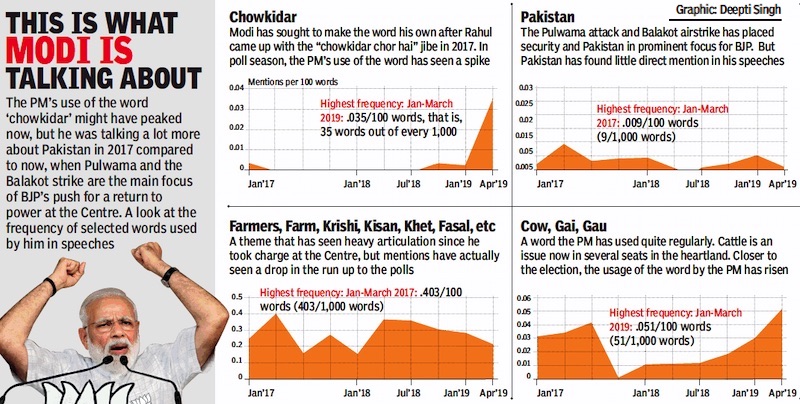
From: April 5, 2019: The Times of India

From: April 5, 2019: The Times of India
See graphics:
The words used most frequently by Narendra Modi during the 2019 elections-I
The words used most frequently by Narendra Modi during the 2019 elections-Ii
2024: Varanasi
Rajeev Dikshit, June 5, 2024: The Times of India
Varanasi: Prime Minister Narendra Modi won Varanasi Lok Sabha seat by defeating INDIA bloc candidate and Uttar Pradesh Congress chief Ajay Rai, but his 1.5-lakh vote victory margin on Tuesday marked the closest contest the prime minister has faced since his victory in 2014, and a steep fall from 2019 when he had won by 4.8 lakh votes.
Rai, jubilant even in defeat, claimed he had scored a “moral victory”. As the sole challenger, he had not only stopped Modi from making a new victory margin record but also set one himself — losing to Modi with the smallest margin.
It is not just Modi’s margin that has fallen. He got about 62,000 fewer votes this time (6.1 lakh compared to 6.8 lakh in 2019) despite the total votes in the constituency rising by about 70,000 (from 10.6 lakh to 11.3 lakh). His vote share dropped from 63.6% to 54.2% Modi bagged 6,12,970 votes to defeat Rai, who secured 4,60,457. In 2014, Modi’s victory margin was 3.7 lakh. Earlier in the day, TV news flashes had created a flutter when they showed Rai leading by 6,000 votes after the first three rounds of counting.
Rai’s parliamentary constituency poll management team convenor, Surendra Narain Singh Audhe, said, “In 2014, anti-BJP votes were divided among four contenders, while it was divided be- tween two contestants in 2019. Moreover, this time, an entire chunk of non-BJP votes went to the INDIA bloc candidate. This was the reason for the reduced victory margin.”
But why did Modi’s vote count fall despite the total number of votes polled on June 1 being greater than in 2019? BJP Kashi region unit president Dilip Singh Patel said, “We are scheduling an organisation meeting in which all reasons for the 2024 LS poll performance in Varanasi seat will be reviewed.”
Rai was happy. “The people of Varanasi showered their blessings on me to show the mirror to those who in their arrogance of power raised slogans of notching up 10 lakh votes and had engaged money power and their best force in Kashi to achieve the target of winning the election with the biggest margin. INDIA bloc unitedly shattered this dream,” said Rai, who had finished third in 2014 and 2019.
Early results during counting of votes at Pahadiya Mandi shocked BJP as in the initial three rounds Rai was leading. But once Modi took the lead, he maintained it till the last round. However, the lead increased slowly, unlike the galloping seen in 2014 and 2019 when Modi was in the lead right from the first round.
At Gulab Bagh, where victory celebrations took place late evening, it was evident that the jubilation lacked the vigour of the past two elections.

